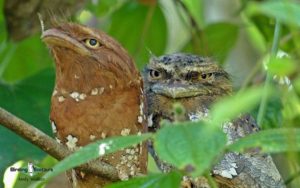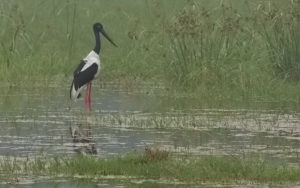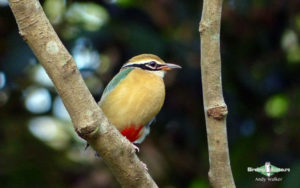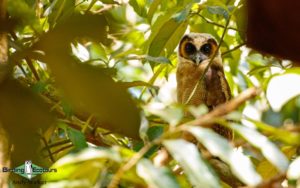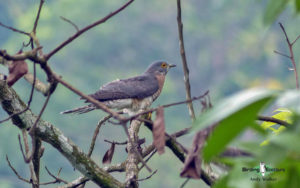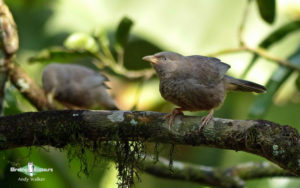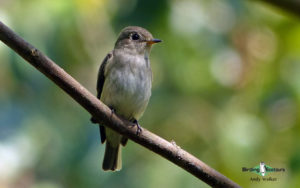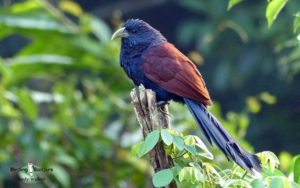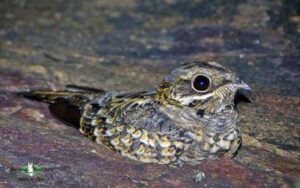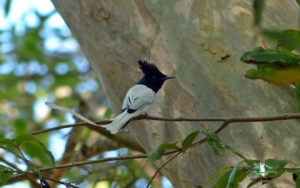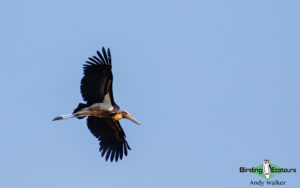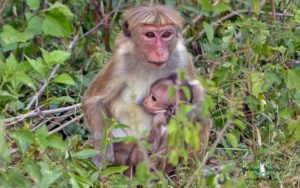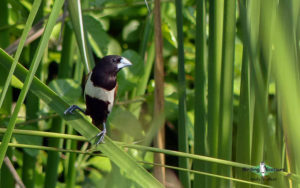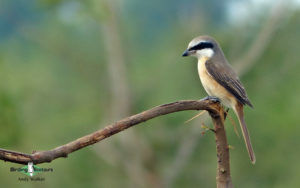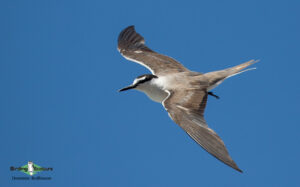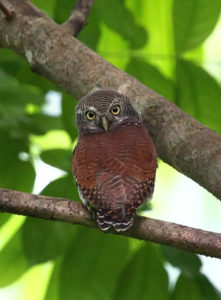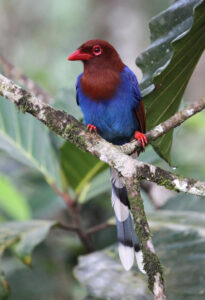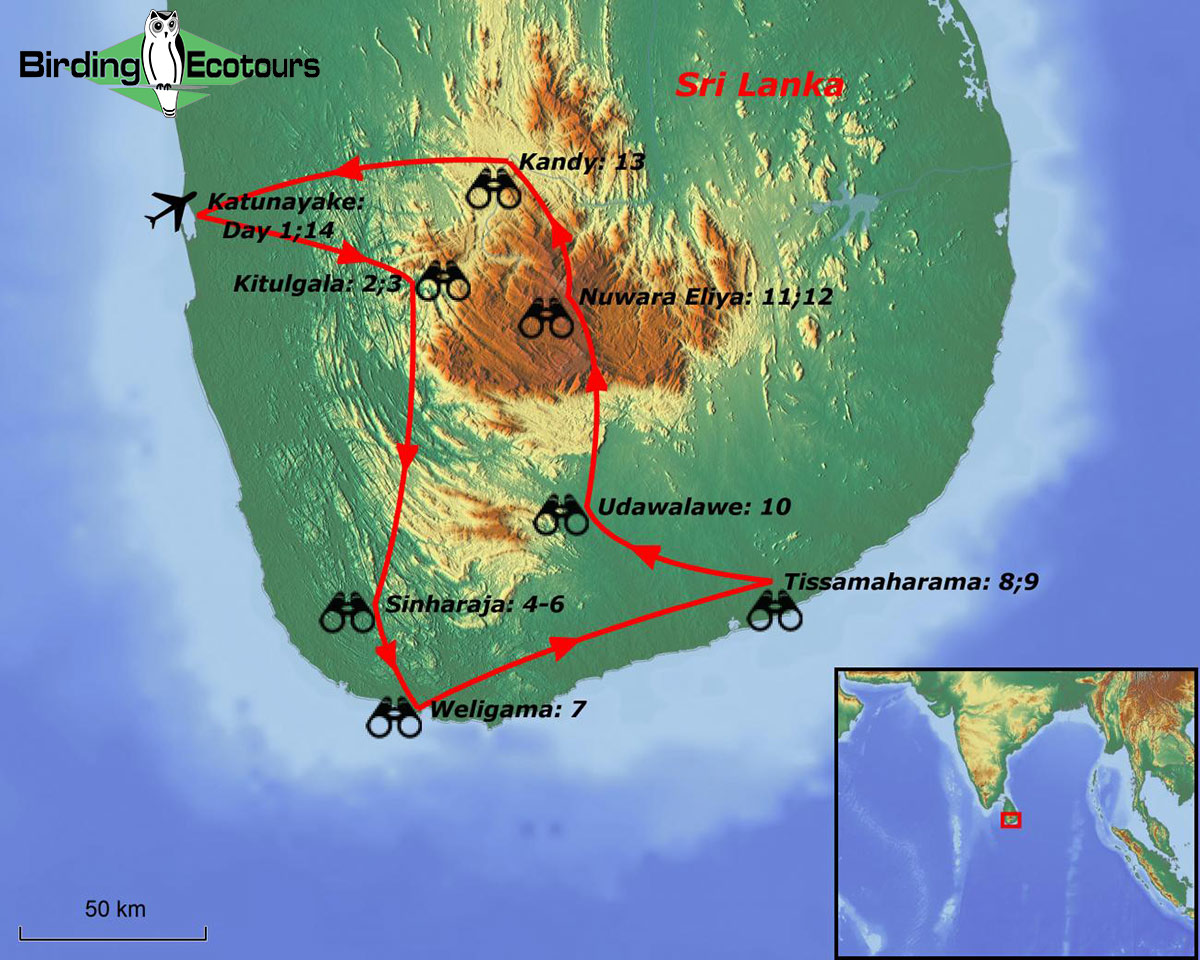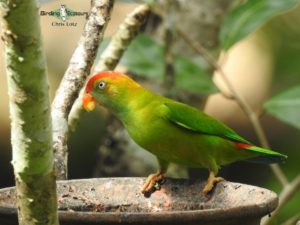Birding Tour Sri Lanka: Island Endemics and Wintering Specialties
Go to: Sri Lanka Birding Tours | Birding Tours in Asia | All our birding tours
Birding Tour Sri Lanka — Island Endemics, Wintering Specialties and Blue Whale Pelagic
January 2026
This exclusive small-group birdwatching tour of Sri Lanka explores the picturesque continental island situated at the southern tip of the Indian subcontinent where we go in search of the country’s mouthwatering endemic birds and wintering specialties.
Sri Lanka is home to 34 currently recognized IOC endemic species, with some of the most impressive ones including the rare Sri Lanka Spurfowl, the gaudy Sri Lanka Junglefowl, Sri Lanka Hanging Parrot, Layard’s Parakeet, the shy, thicket-dwelling Red-faced Malkoha, the tiny Chestnut-backed Owlet, the common Sri Lanka Grey Hornbill, Yellow-fronted Barbet, Crimson-fronted Barbet, Yellow-eared Bulbul, the spectacular Sri Lanka Blue Magpie, the cute Sri Lanka White-eye, and the tricky, but worth-the-effort trio of Sri Lanka Whistling Thrush, Sri Lanka Thrush, and Spot-winged Thrush. We will also look for the relatively recently discovered (2001), Endangered (IUCN), range-restricted, and endemic Serendib Scops Owl, which we will hopefully find on its day roost, as we hope to do with the shy and secretive Sri Lanka Bay Owl too.
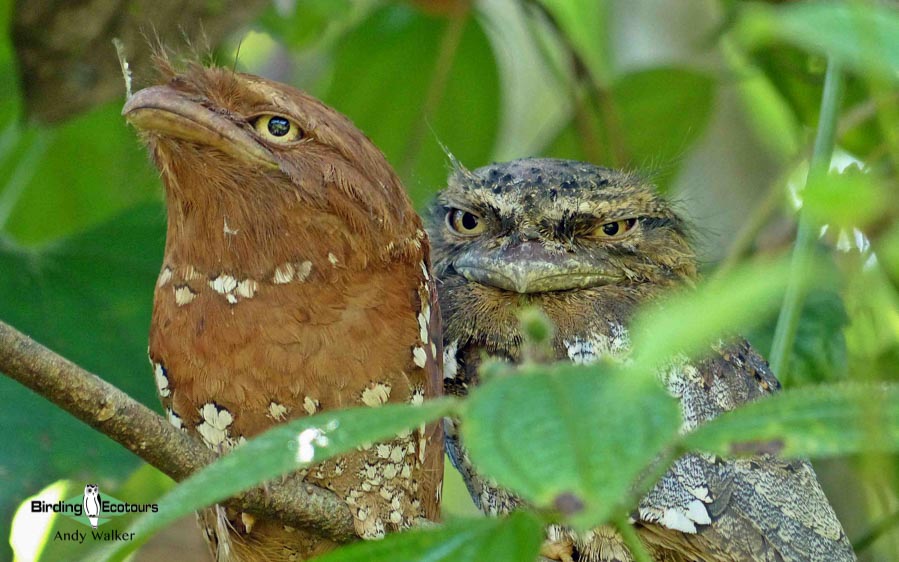
This tour is also timed to coincide with the presence of several overwintering species in the country that are difficult to find at their breeding grounds; these include the boldly patterned and highly skulking Pied Thrush, the pretty Kashmir Flycatcher, and the simply stunning Indian Pitta. There are also plenty of other exciting species possible, such as Lesser Adjutant, Indian Blue Robin, Indian Peafowl, Legge’s Hawk-Eagle, Orange Minivet, Indian Paradise Flycatcher, Forest Wagtail, Malabar Trogon, and Sri Lanka Frogmouth (surprisingly not a Sri Lankan endemic, given its English name; it also occurs in southern India in the Western Ghats, as do a couple of the other birds listed above such as the trogon). Furthermore, Sri Lanka is the westernmost representative of Indo-Malayan flora, and its abundant birdlife also shows many such affinities.
This tour also offers plenty of wildlife-viewing opportunities with Asian Elephant, the Sri Lankan endemic subspecies of Leopard (Panthera pardus kotiya), and Blue Whale all being possible, along with a range of monkeys, squirrels, and deer. The itinerary covers a variety of habitat types, including lowland, monsoon and cloud forests, grasslands, lagoons, coastal mudflats, fresh and brackish waterbodies, imposing riverine woodland, and forest, and will include a pelagic trip off Sri Lanka’s southwest coast into the sparkling Indian Ocean.
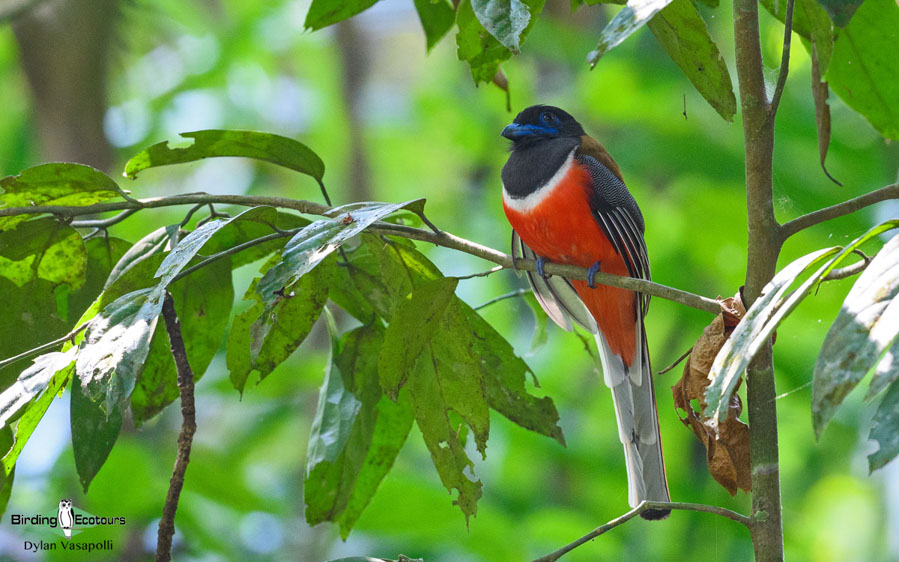
You could combine this tour with our exciting Birding Tour India: Andaman Islands Endemics, designed specially to follow this Sri Lanka tour. This extension will look for numerous endemic birds, including Andaman Serpent Eagle, Andaman Masked Owl, Hume’s Hawk-Owl, Andaman Hawk-Owl, Andaman Woodpecker, and many more!
We have many other Indian tours following after this tour, details of which can be found here.
Itinerary (14 days/13 nights)
Day 1. Arrive in Katunayake and transfer to your hotel near the airport
Arrival in Sri Lanka at the Bandaranaike International Airport in Katunayake and transfer to your nearby hotel with the remainder of the day at leisure. We will have a group dinner together in the evening, our first of many wonderful local meals; the food in Sri Lanka is great!
Overnight: Katunayake
Day 2. Kitulgala for lowland endemics and specialties
We will leave the hotel after breakfast, heading toward the west to our first birding base, the lush lowlands of Kitulgala.
Roadside birding in Sri Lanka is refreshingly good. Blue-tailed Bee-eater, White-throated Kingfisher, White-bellied Drongo, Indian Roller, Sri Lanka Swallow, Scaly-breasted Munia, Brown Shrike, Indian Jungle Crow, Yellow-billed Babbler, Oriental Magpie-Robin, and Ashy Woodswallow are often seen perched on wires. Though we will no doubt see them again and again, these wayside temptations will be hard to resist. The odd Crested Serpent Eagle and Changeable (Crested) Hawk-Eagle, sentinels on posts, will almost certainly bring our vehicle to a halt. The more common waterbirds such as Red-wattled Lapwing, Indian Pond Heron, Eastern Cattle Egret, Intermediate Egret, Black-winged Stilt, and Asian Openbill will certainly not be ignored either.
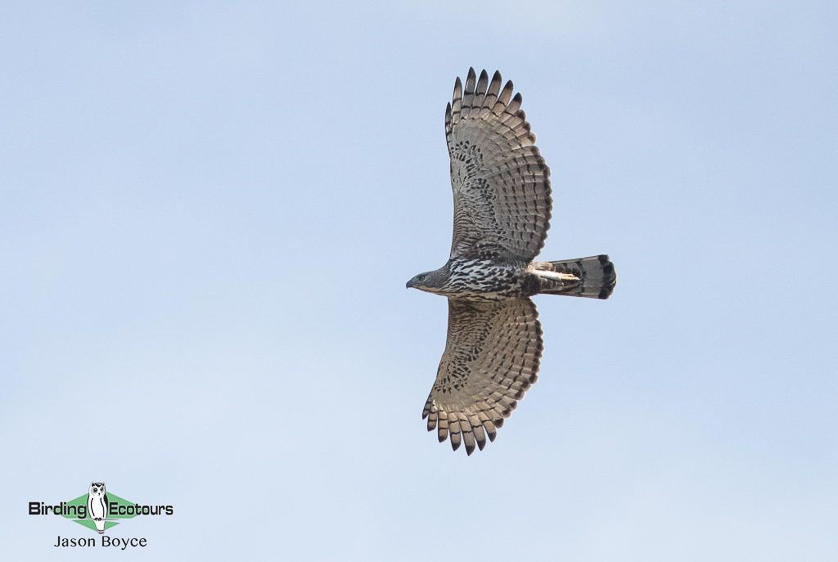
With all these leg-stretching stops it will be close to midday by the time we reach our overnight accommodation, nestled in a well-wooded garden and overlooking the Kelani River, the setting for the renowned ’50s Hollywood blockbuster “The Bridge on the River Kwai”.
After enjoying our first of many rice-and-curry lunches we will commence our quest for the island’s endemics in the well-wooded garden of our lodge. The resonant call of Yellow-fronted Barbet is likely to demand our attention first – a common element in the soundscape of the wet Sri Lankan hinterland. The gregarious Orange-billed Babbler with its constant chattering will be easier to locate. A gem of a bird, Sri Lanka Hanging Parrot – with its specific name beryllinus named after beryl, a semi-precious stone found in Sri Lanka – may require scope views to properly take in its scarlet forehead and rump patch against a greener body.
Our night bird tally is likely to get ticking with the adorable Chestnut-backed Owlet at a stakeout. The well-wooded, home-garden-type birding, combining several patches of habitat, will add a mouthwatering array of birds to our tally in the form of the newly raised-to-endemic Sri Lanka Swallow (perched views on wires), Sri Lanka Green Pigeon, Chestnut-headed Bee-eater, Square-tailed Bulbul, White-browed Bulbul, Yellow-browed Bulbul, Tickell’s Blue Flycatcher, Orange-billed Babbler, Sri Lanka Grey Hornbill, Golden-fronted Leafbird, Black-rumped Flameback, Black-headed Cuckooshrike, Sri Lanka Hill Myna, Common Iora, Purple-rumped Sunbird, Bar-winged Flycatcher-shrike, Orange Minivet, Brown-breasted Flycatcher, Asian Brown Flycatcher, Forest Wagtail, and perhaps Layard’s Parakeet, named after E. L. Layard, a 19th century British civil servant, who added an astonishing 136 species to Sri Lanka’s avian inventory.
Overnight: Kitulgala
Day 3. Full day birding in Kitulgala for lowland endemics and specialties
Spot-winged Thrush may greet the new day with its rhythmic dawn chorus, and it may perhaps come hopping in to find an easy meal at first light. The “pretty-dear” call, likely to be heard in the undergrowth, may betray a flock of Brown-capped Babblers moving low. The Himalayan delight, Indian Pitta, might also be not too far, if you scan well. With more light of the day the dawn chorus may peak with additional tunes of Green Warbler, Large-billed Leaf Warbler, Tickell’s Blue Flycatcher, and the aforementioned thrush, with harsher greetings from Chestnut-backed Owlet.
Our morning’s birding will add a huge boost to our trip list with the likes of Oriental Dwarf Kingfisher, Sri Lanka Drongo, Lesser Yellownape, Indian Paradise Flycatcher, Black-naped Monarch, Black-capped Bulbul, Oriental White-eye, and Sri Lanka Grey Hornbill.
We will cross the Kelani River in search of rarer gems. Foremost among these is the Serendib Scops Owl, discovered in 2001 and with an estimated population of only 200 – 250 birds in the wild. We will look for it at a daytime roost. The ultra-secretive Sri Lanka Spurfowl may require patience, as it is highly wary of people. Crimson-backed Flameback also occurs in this forest and is a gorgeous woodpecker. During the return journey we will pause at a forest patch to look for a roosting pair of Sri Lanka Frogmouth, which is a South India and Sri Lanka endemic.
Overnight: Kitulgala
Day 4. Drive to the endemic hotspot Sinharaja Forest Reserve
After some early morning birding and breakfast we will drive to the amazing Sinharaja Forest Reserve, a UNESCO World Heritage Site, which represents the largest expanse of lowland rainforest in Sri Lanka and the premier site for endemics, where we will get started on the birds listed for days 5 and 6.
Overnight: Sinharaja
Days 5 – 6. Two days birding Sinharaja for lowland endemics and mixed-species flocks
We will have two full days in this birding hotspot, and we are sure to see many great birds. A highlight of birding in Sinharaja is seeing mixed-species bird flocks, which is a strategy adopted by birds in the tropics to maximize feeding efficiency and to reduce the risk of predation; these flocks are likely to be led by Orange-billed Babbler and Sri Lanka Drongo. The star of this coterie of flock-associated specials is the enigmatic Red-faced Malkoha – a canopy-dwelling endemic, found typically at heights of 25-35 meters (82-115 feet), with a remarkable ability to melt away into dense thickets. White-faced Starling too keeps to the canopy. Ashy-headed Laughingthrush, in comparison, is found in bottom levels of the flock, often scratching the forest floor for insect prey, and Malabar Trogon hawks insects in the subcanopy and remains largely silent.
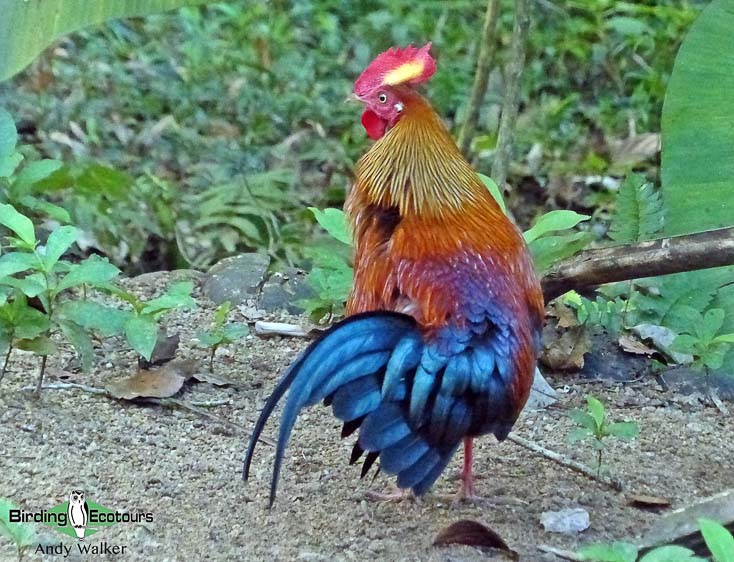
Further target birds we will look for include the montane endemic Sri Lanka Wood Pigeon, which descends to Sinharaja in search of seasonal fruits. With the right technique more bonus birds will come our way in form of Sri Lanka Thrush, Sri Lanka Blue Magpie, Sri Lanka Hill Myna, Indian Blue Robin, Slaty-legged Crake, and Indian Cuckoo.
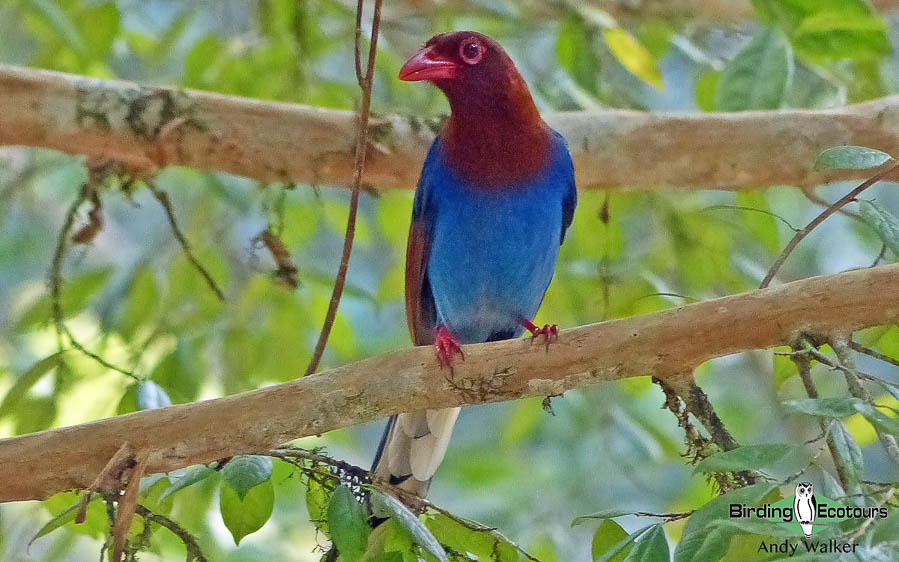
Finding an Indian Paradise Flycatcher sporting its white ribbon-like tail streamers that are nearly a foot in length may be a possibility if we encounter a good flock. Chestnut-winged Cuckoo, another migrant that joins flocks, may, however, present a tougher challenge, as it is not as regular. We will also try for forest raptors like Besra and Crested Goshawk, which lurk behind flocks to catch birds. During the day we may perhaps hear the blood-curdling screams of Sri Lanka (Grizzled) Giant Squirrel, which would betray the presence of more formidable forest raptors such as Legge’s Hawk-Eagle and Black Eagle, soaring high above the canopy. In addition to the above we will try to obtain improved views of the endemics already seen and try to again experience the magic of mixed-species bird flocks.
Overnight: Sinharaja
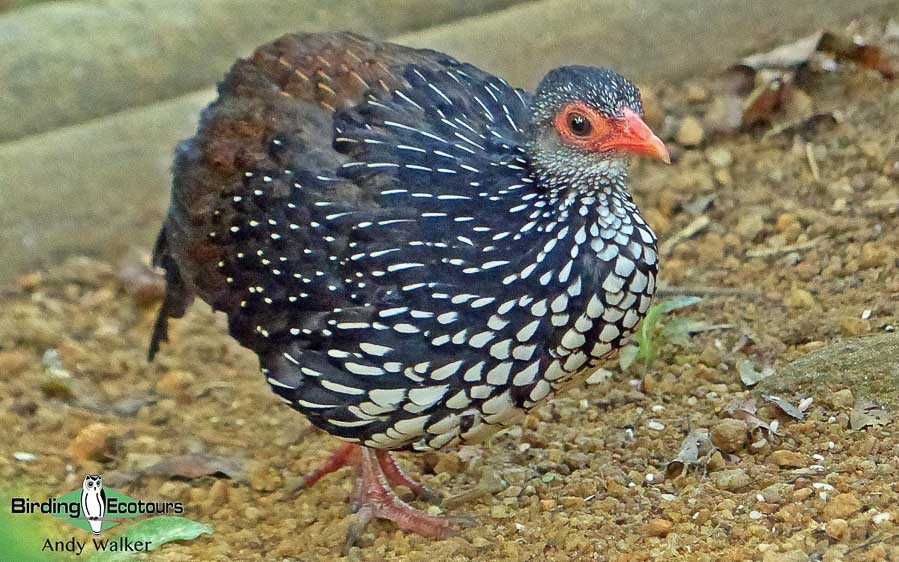
Day 7. Sinharaja and travel to Mirissa
After a final morning birding in Sinharaja we will head to the beautiful southern coast of Sri Lanka at Mirissa to get into a suitable location for the pelagic trip tomorrow.
Overnight: Mirissa
Day 8. Morning whale-watching tour, afternoon travel to Tissamaharama
We will be up early for a really exciting prospect, the chance to go whale watching in the stunning Indian Ocean for the morning. Our main target species is the largest mammal on the planet – the magnificent and unrivaled Blue Whale, which can reach lengths of over 30 meters (over 100 feet)! Seeing these huge creatures will be hard to beat, although we could also possibly find Sperm Whale, Bryde’s Whale, Orca (Killer Whale), Short-finned Pilot Whale, Risso’s Dolphin, Spinner Dolphin, or Long-beaked Common Dolphin. A range of seabirds are possible (e.g. Bridled Tern, Pomarine Jaeger (Skua), Wilson’s Storm Petrel, Brown Noddy, etc.); however, our main focus of the pelagic is on the sea mammals.
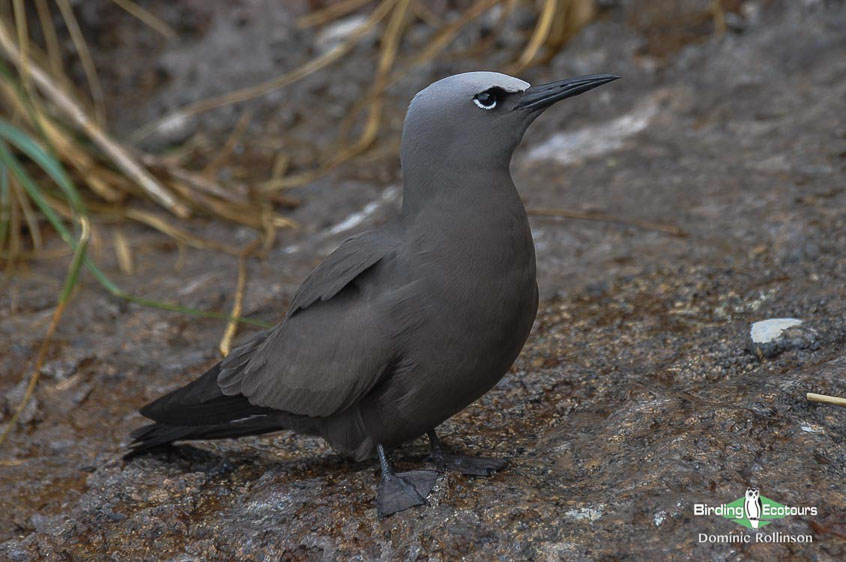
After the pelagic trip we will move up the coast to Tissamaharama, our base for a couple of nights as we explore this excellent area for a wide range of birds. On arrival in the area we will head into some wetlands to start looking for some of the birds listed below.
Overnight: Tissamaharama
Day 9. Morning birding at Bundala National Park, afternoon Yala National Park
We will spend the morning birding the fascinating habitats of Bundala National Park, Sri Lanka’s first Ramsar site. This is the premier site for waterbirds, and you can often get close to the birds in the vehicles to get very good photographic opportunities.
We will get there as early as possible to maximize our time in this wonderful set of habitats. Some of the species possible here are Black Bittern, Yellow Bittern, and Cinnamon Bittern, Watercock, Great Stone-curlew, Indian Stone-curlew, Eurasian Curlew, Marsh Sandpiper, Wood Sandpiper, Green Sandpiper, Lesser Sand Plover, Greater Sand Plover, Little Ringed Plover, Little Stint, Kentish Plover, Red-necked Phalarope, Small Pratincole, Western Reef Heron, Striated Heron, Little Egret, Black-headed Ibis, Glossy Ibis, Eurasian Spoonbill, Black-necked Stork, Little Cormorant, Indian Cormorant, Oriental Darter, Spot-billed Pelican, Yellow-wattled Lapwing, Black-tailed Godwit, Garganey, Northern Pintail, Northern Shoveler, Caspian Tern, White-winged Tern, Whiskered Tern, Common Tern, Greater Crested Tern, Lesser Crested Tern, Little Tern, Brown-headed Gull, and Greater Flamingo. Other species possible in the area include Clamorous (Indian) Reed Warbler, Eurasian Hoopoe, Ashy-crowned Sparrow-Lark, Brown Fish Owl, Yellow-crowned Woodpecker, and Ashy Drongo.
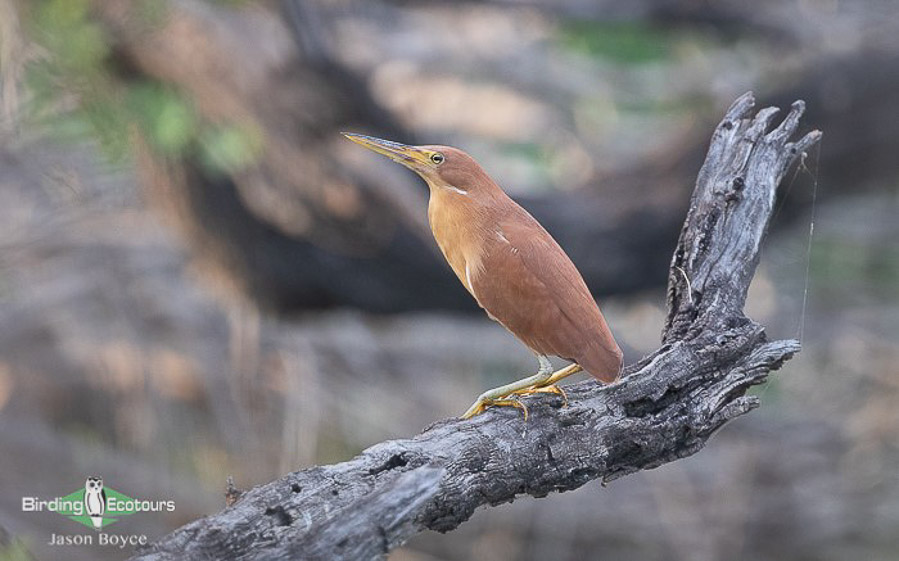
Further species we will look for include Barred Buttonquail, Painted Stork, White-bellied Sea Eagle, Grey-headed Fish Eagle, Greater Painted-snipe, Terek Sandpiper, Orange-breasted Green Pigeon, Grey-bellied Cuckoo, Blue-faced Malkoha, Sirkeer Malkoha, Chestnut-headed Bee-eater, Indian Pitta, Forest Wagtail, Oriental Skylark, Yellow-eyed Babbler, Rosy Starling, Streaked and Baya Weavers, and Indian Silverbill. There really is a huge list of potential species here, and we are bound to have a great time.
In the afternoon we will move the short distance into the nearby Yala National Park for a game drive to look for the Sri Lankan endemic subspecies of Leopard. Here we will also likely come across some of the birds found at Bundala (listed above) and at Udawalawe (listed below). There is also a good chance of finding Asian Elephant here, which is always a treat.
Overnight: Tissamaharama
Day 10. Drive to Udawalawe National Park for dry-zone specialties
In the morning we drive to the dry lowlands of Udawalawe National Park. After checking in at the accommodation we will explore this fantastic park in search of dry-zone birds, which abound here.
The birds on offer here include Sri Lanka Woodshrike, White-bellied Sea Eagle, Green Bee-eater, Blue-faced Malkoha, Coppersmith Barbet, Yellow-eyed Babbler, Rosy Starling, Jacobin Cuckoo, Grey-bellied Cuckoo, Jerdon’s Bush Lark, Ashy-crowned Sparrow-Lark, Indian Pitta, White-browed Fantail, Little Swift, Brahminy Starling, Paddyfield Pipit, Blyth’s Pipit, Orange-breasted Green Pigeon, Spot-billed Pelican, Yellow-wattled Lapwing, Painted Stork, Woolly-necked Stork, Indian Peafowl, Indian Robin, Black-winged Kite, and Indian Stone-curlew. Migrant species like Red-rumped Swallow (with paler red belly and rump). Western Yellow Wagtail, White Wagtail, and Citrine Wagtail may show up too.
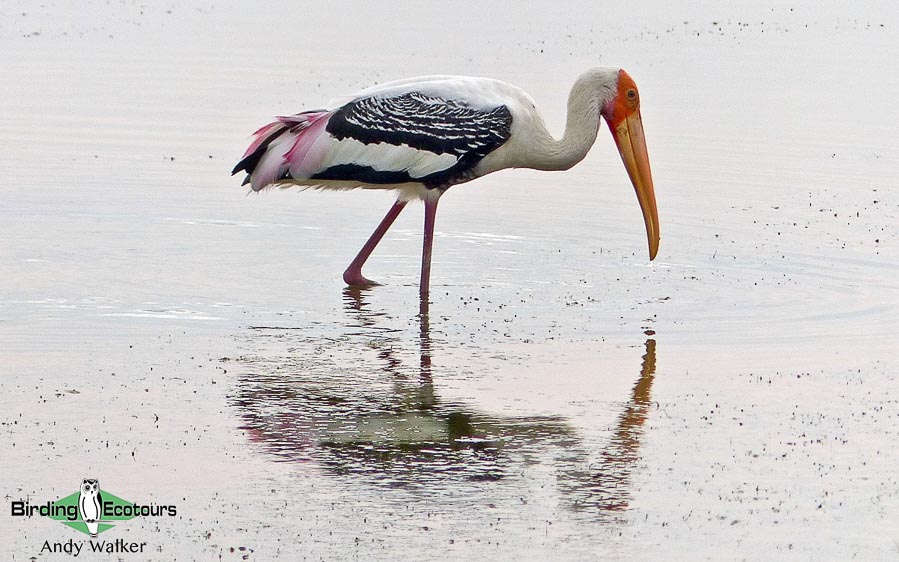
Other birds we will be on the lookout for at Udawalawe National Park include dry-zone specials such as Malabar Pied Hornbill, Sirkeer Malkoha, Indian Silverbill, Barred Buttonquail, Lesser Adjutant, and if lucky Brown Fish Owl. With its vast open expanses the park also harbors a rich diversity of exciting raptors, such as Changeable (Crested) Hawk-Eagle, Crested Serpent Eagle, Grey-headed Fish Eagle, Western Osprey – a local rarity, Pallid Harrier, Montagu’s Harrier – another rarity, Booted Eagle, Shaheen – the resident subspecies of Peregrine Falcon, Common Kestrel, Crested Honey Buzzard, and Shikra. In addition to excellent birds a visit to Udawalawe also presents a good opportunity to observe Asian Elephant and Wild Water Buffalo, both of which are found in good numbers in the park.
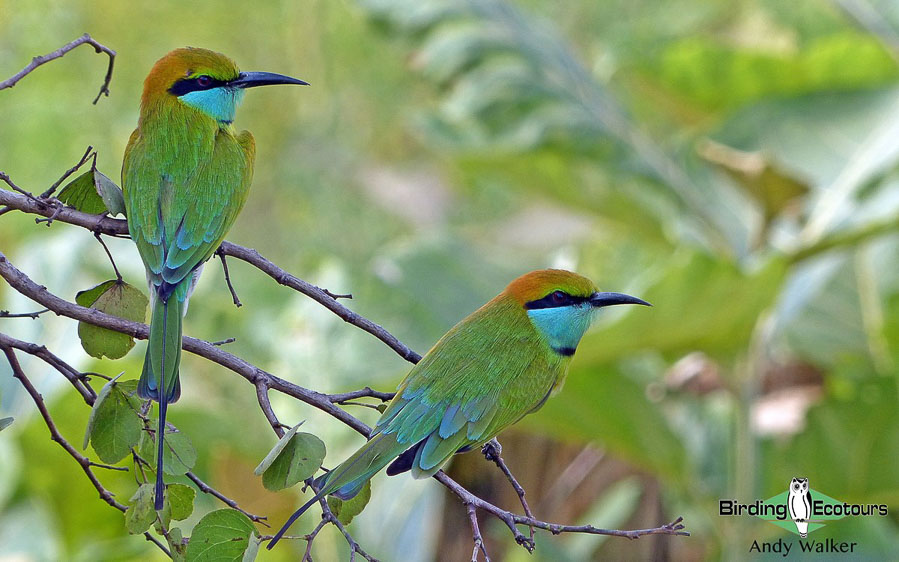
As dusk approaches we will look for Indian Nightjar and Jerdon’s Nightjar in the scrub near our accommodation, likely serenaded by a chorus of Indian Pittas as the sun sets.
Overnight: Udawalawe
Day 11. Transfer to Nuwara Eliya and high-elevation birding
After some more early-morning birding in the Udawalawe area we will commence our ascent to reach the cooler interiors of Nuwara Eliya at 1,890 meters (6,200 feet). We will stop for any good birds noted along the way, but principally the morning is for driving today. Nuwara Eliya is the most famous hill station in Sri Lanka, named by some “Little England”, as it still bears evidence of its colonial past with its English-style holiday homes, an urban park, a few pubs, flower gardens, and a fine 18-hole golf course. As we ascend vast stretches of tea gardens dominate the landscape, a cash crop introduced by the British, which is currently the country’s third-highest revenue earner. A serious drop in temperature of around 10-15 degrees Celsius (50-59 degrees Fahrenheit) at Nuwara Eliya will necessitate sweaters!
Once we reach the town we will explore Victoria Park. Established in 1897 to commemorate the 60th coronation jubilee of Queen Victoria, this urban park is the prime location for Western Himalayan migrants, including Kashmir Flycatcher and Pied Thrush, which winter almost exclusively in Sri Lanka. Indian Pitta, Indian Blue Robin, Forest Wagtail, Sri Lanka Scimitar Babbler, Indian Blackbird, and Sykes’s Warbler are some of the other good birds to be found in this park.
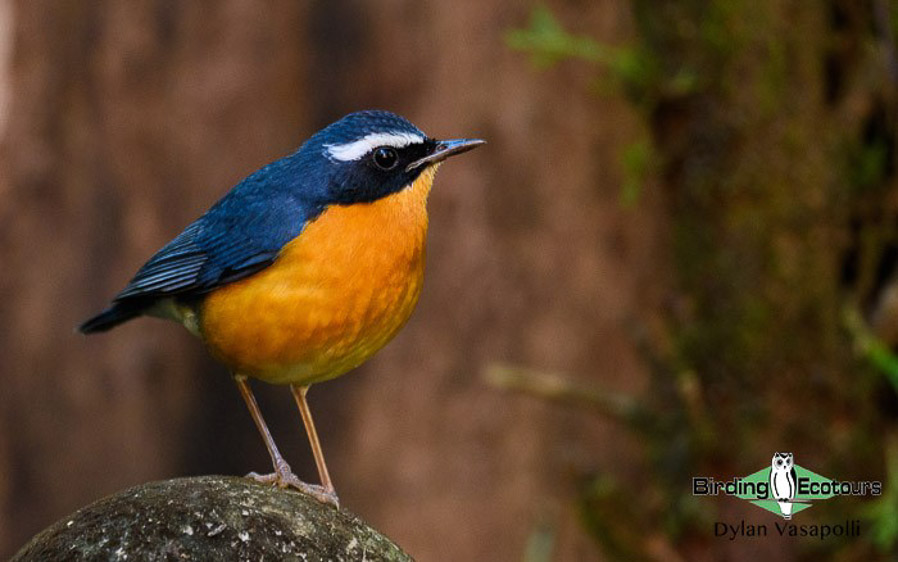
At the end of the day we will reach our cozy highland lodge, where we will stay for two nights.
Overnight: Nuwara Eliya
Day 12. Nuwara Eliya, looking for montane endemics and other specials
We will have an early start with a picnic breakfast to get to the high-elevation Horton Plains National Park, where we will spend time in the forest looking for high-value montane targets: Sri Lanka Whistling Thrush, Sri Lanka Bush Warbler, Yellow-eared Bulbul, Dull-blue Flycatcher, Sri Lanka White-eye, and Sri Lanka Wood Pigeon. Mixed-species bird flocks are to be found in this forest, comprised of both white-eye species, Orange Minivet, Velvet-fronted Nuthatch, Grey-headed Canary-flycatcher, and Bar-winged Flycatcher-shrike.
In the afternoon we will descend back to near Nuwara Eliya, where we will reach a patch of habitat close to our accommodation in time to anticipate the arrival of the ultra-secretive, montane, endemic Sri Lanka Whistling Thrush, which is one of two Endangered (IUCN) Sri Lankan endemics.
Overnight: Nuwara Eliya
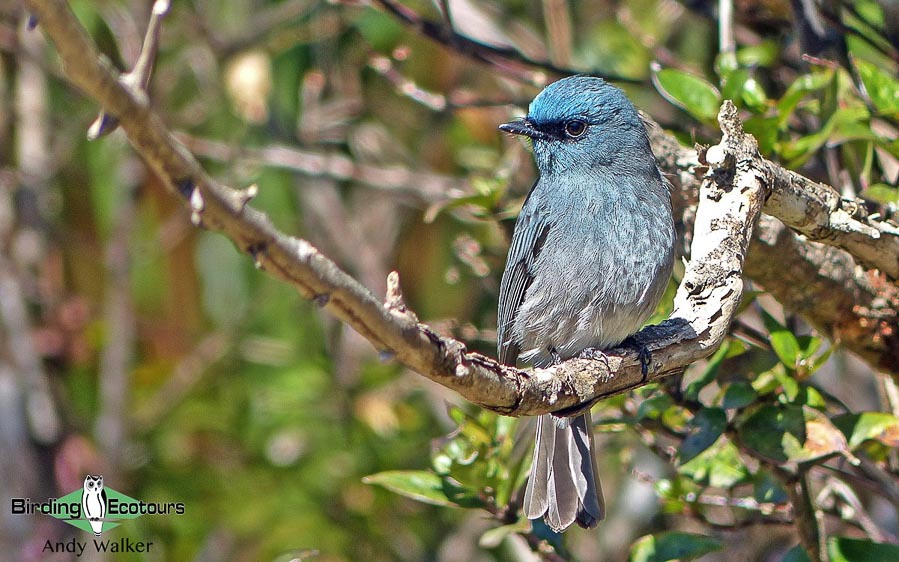
Day 13. Drive to Kandy, in the afternoon local birding
In the morning we will be birding for any missing montane specials before driving to Kandy at an elevation of 477 meters (1,565 feet), the last Sinhalese kingdom in Sri Lanka, which was ceded to the British in 1815. En route we will pause at a tea factory to see the recently split Hill Swallow, which nests inside the factory. After a cuppa we will reach our accommodation, which is a hotel situated close to birding sites and the sacred city of Kandy, a UNESCO World Heritage Site.
In the late afternoon we will go birding within our ample hotel grounds close to Kandy to look for any missing targets. We will also look for several special birds here, namely Oriental Dwarf Kingfisher, Crimson-fronted Barbet and Common Hawk-Cuckoo.
A noisy colony of Indian Flying Foxes will be hard to ignore, and we could see them in their thousands in several large trees next to the river, with constant fights over landing rights.
Overnight: Kandy
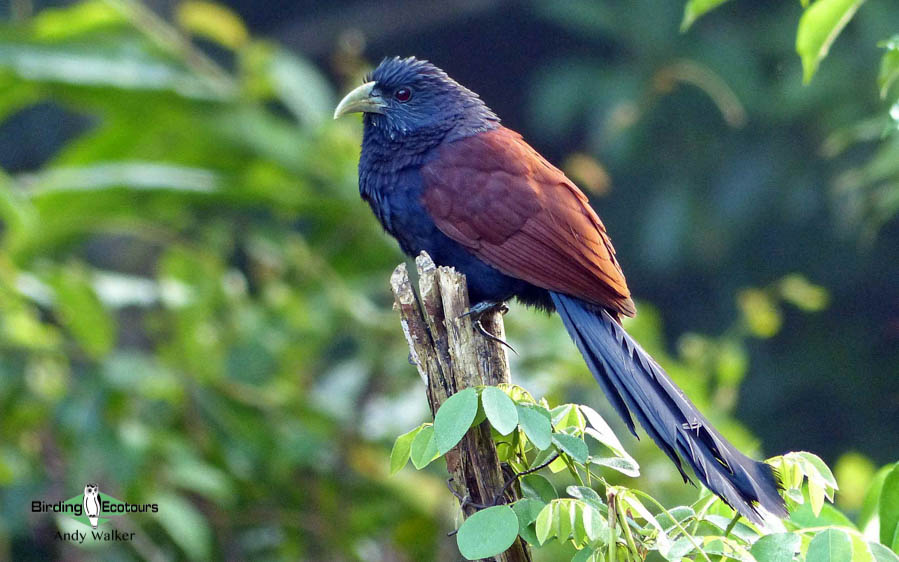
Day 14. Birding around Kandy, transfer to Katunayake for departure
We will finish the tour with some optional pre-breakfast birding around the wonderful gardens of the hotel area. After our final breakfast of the tour we will travel back to Katunayake near Colombo before the tour comes to an end with your afternoon international departure.
If you would like to add some further island endemic birds to your travels you might like to consider our Birding Tour India: Andaman Islands Endemics which runs straight after this tour, during which we will look for Andaman Woodpecker, Andaman Serpent Eagle, Andaman Masked Owl, Andaman Scops Owl, Hume’s Hawk-Owl, and Andaman Hawk-Owl, among many others. Alternatively you may like to consider our Birding Tour India: The North – Tigers, Amazing Birds, and the Himalayas, where we look for Bengal Tiger and some incredible birds such as the monotypic pair of Ibisbill and Wallcreeper and a great deal of other exciting birds such as Cheer Pheasant, Indian Courser, and Indian Skimmer to name a few.
Overnight: Not included
Please note that the itinerary cannot be guaranteed as it is only a rough guide and can be changed (usually slightly) due to factors such as availability of accommodation, updated information on the state of accommodation, roads, or birding sites, the discretion of the guides and other factors. In addition, we sometimes have to use a different international guide from the one advertised due to tour scheduling.
Download ItinerarySri Lanka Trip Report
13th – 26th JANUARY 2019
DOWNLOAD TRIP REPORT
Sri Lanka Hanging Parrot
Overview
Sri Lanka is always incredible, but we enjoy doing our annual trip in January, as Blue Whale is tough to miss during that month and wintering birds such as Indian Pitta, Pied Thrush, and Kashmir Flycatcher can be seen along with the island’s 34 endemics (that are present year-round). The 2019 trip did not disappoint, and we did well with the endemics, wintering birds, mammals (which also included Leopard), and a lot of reptiles and other taxa.
This ended up being a private tour for three Brazilian bird photographers, so we were able to accommodate the pace they wanted to keep. The below is a day-by-day account of the trip, followed by bird, mammal, and reptile lists. E-bird lists are available for virtually all the birding we did; to view these, kindly go to the public e-bird profile of Chris Lotz (Birding Ecotours) and check the lists corresponding to the tour dates.
Detailed Report
Day 1, 13th January 2019: Arrival into Katunayake Airport and transfer to Negombo
The three trip participants arrived today at the Bandaranaike International Airport in Katunayake, serving Sri Lanka’s capital Colombo, and opted to rest at our comfortable beach hotel in Negombo until the next morning.
Day 2, 14th January 2019: Negombo to Kitulgala
We departed at 8:30 a.m. after a leisurely breakfast, giving adequate time for everyone to get a good night’s rest after long flights from the other side of the world. We made frequent stops along the way to Kitulgala, as everything was new and exciting (two of the trip participants had never been to Asia before). The first bird we stopped for was Asian Openbill, but quite a number of other birds were also present at the same place, including Little Cormorant, Red-wattled Lapwing, and the beautiful White-throated Kingfisher, not to mention a massive Common Water Monitor.
A bit further on we stopped at a rice paddy and saw all the possible Egret species, Purple Heron, Indian Pond Heron, Crested Honey Buzzard, a juvenile Changeable Hawk-Eagle, our first of many Brahminy Kites, Blue-tailed Bee-eater, Western Yellow Wagtail, and more.
The best stop of the day (until getting to our lodging) was our opportunity to look at a day-roosting Indian Scops Owl. Another highlight was seeing our first Barbets, two of them endemic (Crimson-fronted and Yellow-fronted) and one more widespread (Brown-headed). We also found our first Black-hooded Oriole, and Joao found (and photographed) White-browed Fantail, while the rest of us enjoyed our first of many Purple-rumped Sunbirds. At the same site was our first of many small flocks of Yellow-billed Babblers.
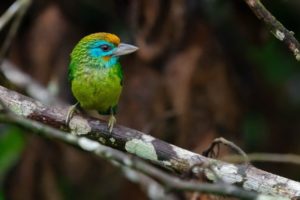
We eventually arrived at the Kitulgala Rest House, where we were to spend the next two nights. What an amazing setting overlooking the Kelani River, where “The Bridge on the River Kwai” was filmed!
We immediately sat down for a late lunch but had to keep jumping up to look at new trip birds between courses. So many birds put in appearances, such as Black Eagle, White-bellied Sea Eagle, Indian Cormorant, the endemic Sri Lanka Green Pigeon, Green Imperial Pigeon, Asian Koel, Indian Swiftlet, the endemic Sri Lanka Grey Hornbill, and Brown-capped Pygmy Woodpecker.
One of the great things about the place at which we were staying was the Sri Lanka Hanging Parrots that came down to the feeder, treating us to really close-up views. The endemic Layard’s Parakeet as well as Alexandrine and Rose-ringed Parakeets were much in evidence. A Ruddy Mongoose also came in to try and get its share of our food, and Indian Palm Squirrels with their beautiful stripy backs were always entertaining, sometimes running along power lines. Here we enjoyed our first Bar-winged Flycatcher-shrike, White-bellied Drongo, and a pair of Indian Jungle Crows that were nice to see after looking at thousands of the abundant (but very entertaining) House Crows along the way. Our first Bulbuls, Square-tailed and the ubiquitous Red-vented, showed well. Common Tailorbird, Oriental White-eye, and Oriental Magpie-Robin were some of the common, widespread Asian species that were also firsts for this tour today.
A beautiful Changeable Hawk-Eagle gave close-up views within the lodge grounds. At one point it hung upside down, and we changed its name to “Bat Eagle”.
We enjoyed looking at the subtle distinguishing features of Asian Brown versus Brown-breasted Flycatchers, species we would become very familiar with in the coming days.
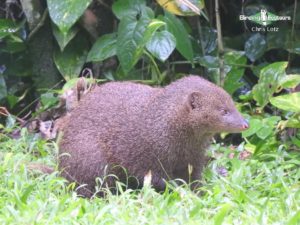
Day 3, 15th January 2019: Full day in Kitulgala
After a 6:30 a.m. breakfast we crossed the river by boat and then did an exciting trail, first through a birdy village and then into the forest proper. We were pleased to find a mixed flock of the endemic Orange-billed Babbler and the more common and widespread Yellow-billed Babbler. We also saw an attractive little Dark-fronted Babbler and later the endemic Brown-capped Babbler. We also found a couple of Malabar Trogons, but not as well as we would have liked. Our first Asian Palm Swifts winged their way over us, and we were pleased to see Sri Lanka Swallows as well. Marshall’s Iora was a really pleasant surprise, along with Common Iora a bit later.
On the way back we got amazingly close views of a pair of endemic, beautiful Spot-winged Thrushes that crossed the road one by one.
An afternoon walk after a delicious lunch was very productive, with the endemic Black-capped Bulbul, Yellow-browed Bulbul, and the very common Square-tailed Bulbul, Southern (Greater) Coucal, Sri Lanka Junglefowl, Shikra, and a gorgeous Common Emerald Dove uncharacteristically giving great views as it walked through a small tea plantation. A flock of Small Minivets showed well, and some group members had already seen Orange Minivets earlier today. Sri Lanka Grey Hornbills were everywhere, and we found their antics and laughing as well as bleating calls very entertaining. Lesser Yellownape and the endemic Red-backed Flameback (now that it has been split from Black-rumped Flameback) were two exotic woodpeckers that we managed to find.
The star highlight of the afternoon was a stunning Chestnut-backed Owlet. What a bird, and yet another endemic! By the end of today we had actually found almost a third of Sri Lanka’s 34 endemics!
On the way back to the car we found a male of the beautiful white form of Indian Paradise Flycatcher with ridiculously long tail streamers – what a bird! A nearby female Tickell’s Blue Flycatcher was also nice to see.
Sri Lanka’s smallest bird, Pale-billed Flowerpecker, as well as the more brightly-colored, endemic Legge’s Flowerpecker were also seen a couple of times today. A small flock of Black-throated Munias put in an appearance too.
A Giant Wood Spider and many butterfly species were also excellent to see during the course of the day.
Day 4, 16th January 2019: Kitulgala to Sinharaja Forest Reserve
We had another 6:30 a.m. breakfast, during which we managed to scope a Grizzled Giant Squirrel (what an impressive animal!) across the river. We then took a fun ride in tuk-tuks up and up to an amazing site at higher altitude, where practically the first birds we saw were gorgeous Sri Lanka Blue Magpies. Soon thereafter a pair of sometimes tricky-to-find White-faced Starlings came to their nest! This is a very localized endemic and quite an interesting-looking bird (although certainly not dazzling). Sri Lanka Drongos were scoped. We also heard Sri Lanka Whistling Thrush but sadly were unable to see it. The same happened with Ashy-headed Laughingthrush as well as Green-billed Coucal, so we’d have to find these three endemics later in the trip. We did get our best views yet of the fabulous Red-backed Flameback, though – what a superb woodpecker! Just as we were about to leave Banded Bay Cuckoo started calling incessantly, and we managed to get it in the scope.
Then we finally went back to the lodge to quickly pack up, check out, and then drive to the next place where we were going to spend three nights, the Blue Magpie Lodge right next to Sri Lanka’s largest intact lowland forest area, the amazing Sinharaja Forest Reserve, a national park that is also a UNESCO World Heritage Site. Exciting days ahead!
When we arrived at the lodge we immediately sat down for lunch. It rained while we had lunch, but there were many birds in evidence as we looked over to the pond below us. We actually amassed 35 bird species in less than two hours within the lodge grounds during and after lunch, while it rained most of the time! A pair of White-breasted Waterhens with a jet-black chick following them around were quite entertaining. Sri Lanka Hanging Parrots and Plum-headed Parakeets flew over. White-throated Kingfisher provided a splash of color, as did Blue-tailed Bee-eaters. White-rumped Munias put in an appearance, and we had further close-up views of Common Emerald Doves. And a couple of Blyth’s Reed Warblers skulked around.
Non-avian highlights included the most massive Common Water Monitor and lots of Indian Palm Squirrels.
After lunch, from their balcony, the group enjoyed getting photos of a pair of Orange Minivets, a female Black-headed Cuckooshrike, and a nearby Yellow-fronted Barbet. A rufous-morph Indian Paradise Flycatcher with its almost foot-long tail was great to compare with the white morph we had seen the previous afternoon. Both Southern Hill Mynas and the endemic Sri Lanka Hill Mynas were at different times “put into the scope”, as was Golden-fronted Leafbird. Brown Shrike watched from a prominent perch for things to eat. Crested Treeswifts also perched on bare branches and flew around, providing good views.
The group also saw a Common Green Forest Lizard eating a grasshopper.
After the post-lunch rest, during which the group photographed birds from the balcony, we were just about to go for a stroll near the lodge when a local guide called us to say he had found a Serendib Scops Owl, possibly the most sought-after bird of Sri Lanka, at its roost! So we quickly took a jeep to the Sinharaja Forest Reserve and had to walk up a really steep trail, but, wow, what a reward awaited us! This is a recently-described Sri Lanka endemic with a population thought to number less than 250 individuals! The Serendib Scops Owl is a peculiar, tiny owl with “false” ear tufts unlike the “true” ear tufts of other scops/screech owl species. There were also a few Purple-faced Leaf Monkeys around.
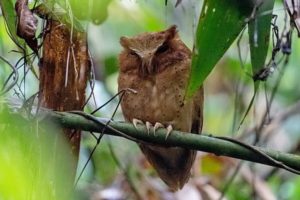
After enjoying this wonderful bird we went back to the lodge for an hour-and-a-half break before dinner. What a spectacular day, despite the fact that three hours of it were spent driving between sites, but the birding we did tended to be pretty relaxing, except for the scramble up to the owl.
Day 5, 17th January 2019: Kudawa section of the Sinharaja Forest Reserve
Starting with coffee at the Blue Magpie Lodge at 5:45 a.m. we heard Chestnut-backed Owlet before journeying to the park, where we had breakfast at the entrance gate, looking and listening for birds. One of the first birds we heard (and glimpsed) as we ascended the trail (we spent about six hours walking this trail) was Sri Lanka Thrush, along with its easier-to-see relative, Spot-winged Thrush. We heard Sri Lanka Spurfowl, but didn’t worry too much since we were to go to a stakeout for this species the next morning, and were accompanied by a tame Sri Lanka Junglefowl for a while.
We actually heard Serendib Scops Owl on the way and went to the day-time roost of Sri Lanka Frogmouth (a female); the latter was voted the bird of the day. A pair of White-faced Starlings suddenly appeared at the frogmouth site. We actually encountered this species quite a few times during this tour, although sometimes it proves tricky.
A couple of Malabar Trogons showed briefly, and the magnificent Crimson-backed Woodpecker paid us an all-too-quick visit before flying far away and drumming/calling extremely loudly. Black-naped Monarch and its more extravagant cousin, Indian Paradise Flycatcher, were around in small numbers during the walk.
A couple of mixed flocks were, as always, extremely exciting! Ashy-headed Laughingthrushes showed very well, as did a cute little pair of Sri Lanka White-eyes. Sri Lanka Scimitar Babbler did not show very well (but we saw this species much better later in the trip). Red-faced Malkoha called once or twice, but we would have to wait until the next day to lay eyes on this beautiful species.
Arriving back at the jeep after our long walk we were rewarded with some really interesting reptiles in the form of Green Pit Viper and a bright green Whistling Lizard, which, however, sat very quietly and didn’t whistle for us. Soon after we started our drive back to the lodge we stopped for a humongous, gorgeous Atlas Moth.
We were all tired after the long walk, so after lunch we only did some relaxed birding around our lodge and the adjacent village. A pair of Black-headed Cuckooshrikes circling around the lodge and landing in some of the big trees at various places within the lodge grounds were fun to see, although they didn’t ever pose long enough in one place for photos. Blyth’s Reed Warbler popped out a couple of times and made itself more visible than usual for this skulking species. We scoped Golden-fronted Leafbird sitting atop a tall palm tree. Legge’s Flowerpeckers and Plum-headed Parakeet flybys also helped to keep us entertained.
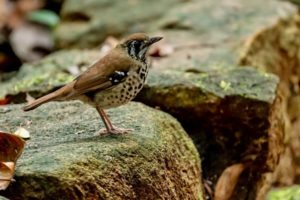
Day 6, 18th January 2019: Sri Lanka Spurfowl stakeout and other sites around Kudawa
We met for coffee at 5:15 a.m. before our half-an-hour jeep journey to the Sri Lanka Spurfowl site. We arrived just before light and were rewarded with great views of some usually-tricky endemics. This is an amazing stakeout, as a pair of the usually really difficult Sri Lanka Spurfowl come in and walk around right in front of people here. Several Sri Lanka Junglefowls do the same thing, and Slaty-legged Crake is also easy to see here. Green-billed Coucal did not cooperate as well as usual, possibly because it was scared of the immature Crested Serpent Eagle perched nearby, so we only heard the coucal calling on a nearby hill and had to wait until later in the trip to get visuals of this species. Ashy-crowned Laughingthrushes, Orange-billed Babblers, and many other star birds did come in close, Sri Lanka Scimitar Babbler also lurked around, and a gaudy Sri Lanka Blue Magpie showed up for a little while. Spot-winged Thrushes came really close to us, and Brown Shrike was also present. Mammal-wise we added a new species to our list, Dusky-striped Squirrel.
We arrived back at the lodge in time for a long rest in the heat of the day, but while we were waiting for lunch we enjoyed some of the birds that lived around the lodge. The most popular of these must have been the orange form of Indian Paradise Flycatcher with its mega-long tail, the ever-present White-throated Kingfisher, and Golden-fronted Leafbird. A magnificent adult Crested Serpent Eagle gave us a good flight show.
In the afternoon we did some birding along the road in the Kudawa area. We managed to see Green-billed Coucal, but not very well. Apart from that we enjoyed a good number of bird species we had already seen earlier during the trip, along with a couple of new lizards. One of them was Sri Lankan Kangaroo Lizard, a small lizard with kangaroo-like, big hind legs and smaller front legs. The other one was an Eastern Garden Lizard.
Day 7, 19th January 2019: Kudawa section of Sinharaja Forest Reserve, transfer to Mirissa
This proved to be yet another spectacular day! Soon after we arrived in the reserve we located a large mixed flock. After about half an hour of enjoying species we’d already seen before we located three Red-faced Malkohas! These beautiful endemics put on quite a show, as two of them decided to fly right towards us, landing in a tree just in front of us. They didn’t stay long but did provide reasonable photo opportunities. A pair of Green-billed Coucals also put on quite a show, and White-faced Starlings showed yet again.
We later found another really superb mixed flock that contained Lesser Yellownape, another Green-billed Coucal that Joao spotted right next to the trail, Sri Lanka Scimitar Babbler, Sri Lanka Blue Magpie, and many other star birds, albeit ones we’d seen before. We did get views, however, of a pair of Black-naped Monarchs that had previously only given us glimpses. We also saw Large-billed Leaf Warbler, but although we had poor views at least we heard it calling to clinch the ID. The star birds, however, were three Velvet-fronted Nuthatches, a species we hadn’t seen yet.
Carnivorous pitcher plants were fascinating to see.
On the rough jeep drive back to our hotel for our final lunch there before departing for the south coast at Mirissa we found our first Indian Peafowl, a ubiquitous bird during the second half of our itinerary, though.
During the three-hour journey to Mirissa we saw some nice roadside birds such as a Black-headed Ibis, Painted Stork, and White-bellied Sea Eagle.
Day 8, 20th January 2019: Mirissa pelagic, transfer to Tissamaharama, birding on the way
We started the day with a spectacular pelagic trip looking for Blue Whales, which we saw well! In addition we also enjoyed seeing lots of Spinner Dolphins on the way, the small/young ones leaping out of the water and spinning playfully. We also approached a pair of Green Turtles and saw a Sailfish as well as good numbers of Flying Fish. Birds were scarce, but we did add some tern species to our growing trip list.
After the boat trip we stopped for a delicious, spicy lunch before driving for a couple of hours to the Hambantota salt pans, where we found a lot of shorebirds (waders). These included Eurasian Spoonbill, Black-headed Ibis, many Black-winged Stilts, Grey (Black-bellied) Plover, Lesser Sand Plover, Curlew Sandpiper, Little Stint, Common Redshank, Common Greenshank, and Marsh Sandpiper. There were several Tern species present, namely Caspian and Little on opposite ends of the size spectrum and the in-between-sized Gull-billed, Whiskered, and White-winged. We’d seen Greater Crested Tern on the pelagic, so it was a good day for terns. We also found our first Striated Heron here as well as a close-up juvenile Shikra.
The last stop of the day was extremely exciting from a birding point of view, and we found 57 bird species within the time of two hours. The site was Debarawewa Lake, but we first had a few non-waterbirds to see in the area. Two of the first species we found were superb owls, Jungle Owlet and Brown Fish Owl. While looking for these we found Jerdon’s Leafbird, Brown-headed Barbet, White-browed Robin, Indian Robin, and a lovely Gray-breasted Prinia that we scoped as it sang from atop a tree.
The marshy areas were full of birds, including Yellow Bittern, Black Bittern, Lesser Whistling Duck, Spot-billed Pelican, loads of Grey-headed Swamphens, Eurasian Moorhen, Painted Stork, Asian Openbill, and large numbers of Indian Cormorants flying over in flocks to roost sites just before it was getting dark. A lot of Rose-ringed Parakeets also started coming in to roost toward the end of our birding session. Chris saw Coppersmith Barbet and a fabulous White-naped Woodpecker. A beautiful White-bellied Sea Eagle flew past at one point.
Indian Flying Foxes, Southern Gray Langur, and huge Muggers (Marsh Crocodiles) were three of the non-avian species we enjoyed.
As it was starting to get dark we checked into our comfortable hotel in Tissamaharama, where we’d spend the next two nights, poised well to tackle the famous Yala National Park the next day.
Day 9, 21st January 2019: a full day in Yala National Park
We spent an entire day inside the beautiful Yala National Park, which unfortunately is by no means a “best kept secret” and is infamous for becoming crowded with tourists looking for the Sri Lankan subspecies of Leopard. This was our main target today, and while this is arguably the best place on the planet for this beautiful cat, Leopards are always elusive. We got our first sighting of one in the mid-afternoon as it quickly ran across the road in front of us and vanished! We had to wait perhaps an hour and a half more before jeeps started rushing past us; obviously there had been a sighting of another Leopard further on. So we followed, only to get stuck behind a line of vehicles. We did have an open area to the right of us (Yala National Park is dry, but densely wooded with lots of thickets), and we basically just hoped the Leopard would move in the right direction and move into the open area. We didn’t feel the chances were very high, but after perhaps 15 minutes of waiting we saw a Black-naped Hare running for its life (literally, I guess). We struggled to contain our excitement, and suddenly Ana spotted the Sri Lankan Leopard at the edge of the open area. It then came into view for all of us and sat down like a dog, allowing great views and photos. After a while it moved off, providing some further good views. What a relief to finally get a proper sighting of this magnificent animal, only 40 minutes before we were due out of the park at 6:00 p.m.!
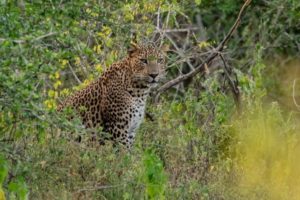
During the course of the day we also saw Asian Elephant, wild Water Buffalo, the pretty Spotted Dear, Sambar, Wild Boar (one pair of these was accompanied by a bunch of tiny piglets), Southern Grey Langur, quite a few Common Indian Monitors, a couple of Muggers (Marsh Crocodiles), and other animals.
We also recorded 93 bird species within the park, but since we were focusing on finding Leopard, we didn’t take very much time to get everyone onto all of them. We also knew that the next day we’d have adequate time for finding a lot of the arid-zone birds. I certainly don’t want to downplay the birding, though; in reality it was actually spectacular! We enjoyed close-up views of two dazzling Bee-eaters, Green (abundant) and Chestnut-headed. We also enjoyed seeing our first Yellow-wattled Lapwing among the more common Red-wattled Lapwing. We also added some more shorebirds to our list, such as Common Sandpiper, Wood Sandpiper, and a very nice Pacific Golden Plover. A spectacular but ugly Lesser Adjutant and its more beautiful cousins Painted Stork and Asian Openbill were great to see. Grey-headed Fish Eagle also showed up.
Lunch on the beach (this amazing park is indeed right on the coast) allowed us to see a few good birds, such as a lot of Purple Sunbirds, a couple of Plain Prinias, etc.
Blyth’s Pipit, Paddyfield Pipit and Jerdon’s Bush Lark were great to see even though being LBJs (Little Brown Jobs). More strikingly attractive were Ashy-crowned Sparrow-Larks. We enjoyed Streaked Weavers (and we saw the impressive nests of Baya Weaver), two Munia species, Tricolored and Scaly-breasted, and several Malabar Pied Hornbills.
Probably the bird of the day, because it was the only Sri Lanka endemic, was Sri Lanka Woodshrike, which we saw well. We also added another beautiful green pigeon to our list, Orange-breasted Green Pigeon, and were really pleased to see another pair of Brown Fish Owls on a branch pretty much right above us – we had close-up views! Yellow-crowned Woodpecker also gave excellent views. A flock of Brahminy Starlings and several flocks of Rosy Starlings were around, and there were lots of Indian Robins and a few White-browed Fantails along with some Indian Paradise Flycatchers, the latter including a dazzling white form with its unbelievably long tail. And Eurasian Hoopoe is always a real treat!
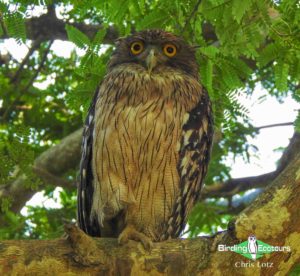
Day 10, 22nd January 2019: Udawalawe National Park
The day started with an Indian Pitta and many other birds near our hotel. A male and a female Asian Koel as well as a pair of Indian Silverbills showed very well, as did a lot of other birds not listed here because they were seen earlier in the trip and thus have already been mentioned.
We then went to Tissa Lake to witness the large roost of Indian Flying Foxes in large trees shared with breeding shorebirds such as Grey Heron and cormorants. We were very pleased to find Cinnamon Bittern, three Cotton Pygmy Geese, Great Cormorant, Common Kingfisher, Zitting Cisticola, and other new trip birds. Our closest-yet encounter with beautiful Pheasant-tailed Jacanas was a delight to the entire group.
We then embarked on the 1.5-hour drive to our lodge just outside of Udawalawe National Park and arrived just in time for lunch. An afternoon jeep outing into the park was lots of fun and very rewarding, with quite a number of new birds being added to our burgeoning list. We enjoyed several Prinia species in the form of Plain, Jungle, Grey-breasted and Ashy. Yellow-eyed Babblers and four Grey-breasted Cuckoos were two of the targets we managed to find without problems. A good number of Orange-breasted Green Pigeons showed extremely well, and a few Indian Rollers were also seen. A couple of large flocks of Rosy Starlings were around too. In addition we saw a beautiful pair of White-bellied Sea Eagles, a close-up Changeable Hawk-Eagle, and quite a number of waterbirds, including a couple of new ones like Little Ringed Plover and Green Sandpiper.
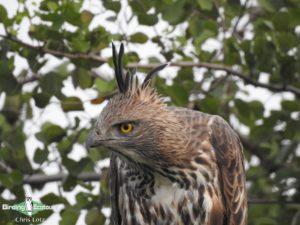
Day 11, 23rd January 2019: Udawalawe to Nuwara Eliya
We left our hotel at 8:00 a.m. and got to Nuwara Eliya at an elevation of 1890 meters (around 6000 feet) just in time for another delicious lunch. At 2:30 p.m. we headed to Victoria Park, where we enjoyed a couple of hours of spectacular birding. We found two tough migrants, both males in brilliant plumage, in the form of Pied Thrush and Kashmir Flycatcher. We also saw our first Sri Lankan highland endemic, Yellow-eared Bulbul, along with a good number of birds we’d already seen. And we thoroughly enjoyed seeing a couple of Forest Wagtails.
We still had another hour or so before it got dark, so we headed to our Sri Lanka Whistling Thrush site but only got glimpses of it. Chris also saw a superb male Indian Blue Robin, but sadly it vanished before the others could get onto it.
Mammal-wise we saw Toque Macaque and some other mammals we’d already seen.
We didn’t have many hours of birding today, but when we did bird, the quality of the species was incredible, and we also were now poised to spend a whole day in the beautiful, cool highlands, a world away from the hot lowlands we’d spent most of our time in.
Day 12, 24th January 2019: Full day in the highlands around Nuwara Eliya
At 6:00 a.m. we headed to Horton Plains National Park, a picturesque area of short grassland punctuated by colorful patches of cloud forest – some of the trees are red or brown, etc., not to mention all the shades of green. Just before entering the park we stopped at our stakeout for Sri Lanka Wood Pigeon and were immediately greeted by about 20 of them. We also enjoyed some more Yellow-eared Bulbuls, a common Sri Lanka endemic throughout this highland area. After entering the park proper it didn’t take us long to find some Dull Blue Flycatchers, but we had to work harder to get views of Sri Lanka Bush Warbler. That basically finished off all 34 endemics for us, except that we had had only had glimpses of Sri Lanka Thrush and Sri Lanka Whistling Thrush, and while we had planned to dedicate the following 24 hours to seeing them properly, since the group was tired and wanted photos rather than simply visuals in bad light, we opted to instead take it easy. We did also get excellent views of some endemics we’d seen previously, including Sri Lanka Scimitar Babbler and Sri Lanka White-eye.
We enjoyed a few other good birds as well, such as close-up Hill Swallows, lots of Pied Bush Chats, and three separate Himalayan Buzzards. We also saw some majestic male Sambars as well as a cute Northern Red Muntjac (Barking Deer). All in all it was a worthwhile morning, and we were able to reward ourselves with another tasty lunch.
In the afternoon we headed back to Victoria Park for some relaxed birding. When we met at the van a Loten’s Sunbird sat in the sun singing and showing off its iridescent colors. At the park we tried to find Sri Lanka Thrush again, but it didn’t even call today. We did, however, find one new trip bird in the form of Indian Blackbird. Apart from that we enjoyed some species we’d seen before, including the male Kashmir Flycatcher.
Day 13, 25th January 2019: Nuwara Eliya to Kandy
We opted not to bird this morning but instead to “sleep in” and start the day with a 7:30 a.m. breakfast (is that really sleeping in?). We then drove to Kandy, stopping at a fascinating tea factory en route. Sri Lankan (Ceylon) tea is of course the most famous tea in the world.
Kandy, a compact city surrounded by a river and hills and populated by around 315,000 people, is a fascinating place to spend a couple of hours. We visited a silk store (where we also had lunch) and a souvenir store before driving up to a viewpoint to view the very pretty city and its sights from above.
We then drove the half hour or so to our beautiful hotel, which had great birding on the grounds. During an hour or so birding here we had great views of Common Hawk-Cuckoo and many birds we’d already seen, a good number of them endemic to Sri Lanka. Just before dinner we also did a night walk for Indian Giant Flying Squirrel, which we found without too much effort just in time to see its spectacular flight from one tree to another! What an animal, and what a show!
Day 14, 26th January 2019: Kandy and departure
We spent the morning at the Royal Botanical Gardens in Kandy before going back to our hotel to shower and have lunch before our drive back to the Katunayake airport for our flights home. The Botanical Gardens were truly amazing, one of the highlights being an Indian Pitta right next to us, in the open, posing for photos! We also saw another huge colony of Indian Flying Foxes plus our one and only Rock Terrapin. We enjoyed the nice diversity of birds here and equally enjoyed the massive fig trees and other beautiful trees and plants.
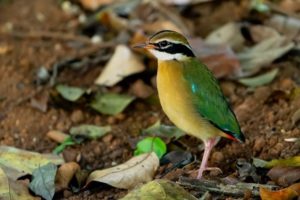
What a spectacular two-week tour this proved to have been! Because of the trip participants’ preferences we made this a photographically-paced tour and therefore missed some sites that would have padded our list a lot with widespread shorebirds etc. that didn’t interest us, since this was effectively a private tour. While this annual January set-departure tour is not a photography tour, all participants on this particular one were actually bird photographers, so we transformed it into a birding photo tour to some extent.
Please see the downloadable PDF above with the full species lists included. This is a sample trip report. Please email us ([email protected]) for more trip reports from this destination.
SRI LANKA: ISLAND ENDEMICS, WINTERING SPECIALTIES, AND BLUE WHALE PELAGIC
GENERAL INFORMATION
OUR SRI LANKA BIRDING TOUR
This small-group Sri Lanka birding tour focuses on the 35 currently recognized IOC (14.2) endemic birds, several near-endemic regional specialties that only also occur in a relatively small area of southern India, and several overwintering specialties. Some of the main targets on this birdwatching tour of Sri Lanka include Serendib Scops Owl, Sri Lanka Bay Owl, Chestnut-backed Owlet, Sri Lanka Frogmouth, Sri Lanka Spurfowl, Sri Lanka Junglefowl, Sri Lanka Hornbill, Indian Pitta, Malabar Trogon, Red-faced Malkoha, Sri Lanka Blue Magpie, Sri Lanka Thrush, Sri Lanka Thrush, Pied Thrush, Indian Blue Robin, Kashmir Flycatcher, and many more.
Our tour will take us around the south of the picturesque island nation, soaking in a wide range of habitats along the way. In addition to the high-quality birds, we will keep our eyes peeled for Asian Elephant, (Sri Lankan) Leopard, and, while on a pelagic trip, the massive Blue Whale.
This Sri Lanka birding tour starts and ends at Bandaranaike International Airport in Katunayake, near the Sri Lankan capital, Colombo.
ITINERARY AND SPECIES RECORDING (BIRD LISTS AND ANIMAL LISTS)
Ahead of our Sri Lanka birdwatching tour we will send you a detailed daily itinerary (along with arrival instructions). We will then provide you with a printed copy of the itinerary on the first day of the tour.
The printed copy of the itinerary will include a bird list and list of other animals possible on the tour and we will go through this each night (but it is totally optional whether you join or not – though it is considered extremely useful). We always use the latest version of the International Ornithological Congress (IOC) taxonomy for our bird list and for all other wildlife, we use the International Union for Conservation of Nature (IUCN) taxonomy. While birding during the tour we will create eBird checklists and these will be shared with any participants who wish to have a copy. Just provide us with your eBird user details at the beginning of the tour for us to do this.
Each evening, we will go through the itinerary to give you any specific information to be aware of for the following day (like what clothes and equipment will be needed, when we will be having breakfast, departure time from the hotel, and any important birds we will be looking for, etc.). This is a good time for you to ask us any questions you may have for the day ahead.
After the completion of the tour, we will email you a PDF copy of an illustrated trip report. This will include a complete IOC and IUCN checklist of all wildlife recorded during the tour. Any interesting bird, animal, or landscape photographs will be included in the trip report and will also be added to our tour-specific Flickr pages as a reminder, and you are able to download these for free and share with your friends and family.
DAILY ACTIVITIES, PHYSICAL REQUIREMENTS, AND TOUR PACE
This Sri Lanka birdwatching tour is not considered to be too physically demanding, though heat and humidity throughout the tour can increase tiredness and care should be taken to remain hydrated at all times.
There are a couple of long hikes during the trip, but we always take these slowly and go at birdwatching pace. If you do want to sit out a birding session, there are opportunities to hang back at our accommodation for some more relaxed birding or photography at several locations. We will spend the majority of our time birding on easy to moderate trails and roadsides, at a range of elevations, and will experience warm/hot and humid conditions throughout.
This is a birding-focused tour that does offer some good incidental photo opportunities, though these are secondary to the actual birding element of the tour. Finding and seeing well the many endemic and near-endemic species and subspecies of Sri Lanka, as well as overwintering specialties, will be considered the priority. That said, some good photo opportunities are available at many of the sites we will be visiting, though conditions can be tough in the forested, more enclosed, areas we will visit.
Most of the drives between different sites are two to three hours, but there are also a couple that are around the four hour mark. Please note that on longer journeys our driver may need to take a short break for safety. This will generally be done at a place where there is some birding for us, or where we will have lunch. Everyone’s safety is our concern on this and all our tours. There are a couple of long, rough, and potentially dusty jeep rides on this tour. We will also be taking a whale-watching pelagic boat trip during the tour. There are more details in the “Transportation” and “Pelagic” sections below.
At a couple of locations, we will be birding from within open-topped jeeps/vans due to site regulations, often for our own safety (e.g. in areas where there are elephants or leopards).
PASSPORT, VISA, LOCAL LAWS, AND CUSTOMS
In order to visit Sri Lanka, most visitors will require a visa which can usually be obtained on arrival in the country. The online visa (eVisa) application system is currently (August 2024) suspended, though this may change in the lead up to the tour, so worth checking. To enter the country your passport must have an expiry date at least six months after the day you arrive.
You are required to complete an online arrival form up to three days before you arrive in Sri Lanka. This is a free service (don’t fall for online scams claiming you need to pay) and this can save time on arrival. Please refer to the department of Immigration and Emigration website for further up-to-date information, and also check the advice provided by your government. There are strict rules about goods you can take into or out of Sri Lanka, with details here.
On arrival in Sri Lanka, you will likely have to show evidence of your ticket to leave the country after your bird holiday. Please make sure that you have all the required documents, and please contact us if you have any questions.
You must always carry your passport as an official form of identification. A copy is usually acceptable, but in some situations you may have to produce the original at a police station, within a specified time limit.
Do not fly drones near, use binoculars or telescopes, or take photographs of military bases, government buildings, or vehicles used by VIPs. Drones require a permit in Sri Lanka.
Disrespecting Buddhist images and artefacts, or making offensive remarks about religion, is a serious offence and can lead to arrest. If you have visible tattoos of Buddha, you can be refused entry to Sri Lanka or face deportation. Do not pose for photographs standing in front of a statue of Buddha (don’t pose for photos with your back to Buddha). Avoid touching sacred objects or relics. Always seek permission before photographing people, particularly monks or worshippers. Public displays of affection are frowned upon in Sri Lanka. It is best to avoid overt displays to respect local customs and traditions.
Please make sure that you bring a photocopy of your passport with you on the tour, this can be kept with other important documents like vaccination certificates, emergency contact details, and insurance documents.
TRAVEL INSURANCE
As detailed in our standard Terms and Conditions, we strongly encourage you to have comprehensive trip cancellation insurance to protect against unexpected events that might cause delays and interruptions to travel. It is important that the insurance covers illness, medical issues, accidents, repatriation, loss of luggage or any valuable items that you might be bringing (e.g. optical and camera equipment) etc.
HEALTH AND PESTS
We recommend you consult your doctor or local travel clinic, regarding vaccine requirements, approximately two months prior to your bird tour to Sri Lanka, so that any required vaccine courses can be completed in time for your departure.
There is no risk of Yellow Fever in Sri Lanka, however there is a certificate requirement for travelers arriving from countries with a risk of Yellow Fever transmission (or have transited for more than 12 hours through one). The certificate for Yellow Fever is now valid for life, rather than 10 years, as was considered to apply pre-2016. Please refer to the World Health Organization’s list of countries where Yellow Fever transmission is possible, here.
Everyone visiting Sri Lanka should be up to date with standard vaccinations and boosters, like Diphtheria-Tetanus-Pertussis, Chickenpox (Varicella), Flu, Covid-19, Polio, Shingles, and Measles-Mumps-Rubella (MMR). Other vaccinations that might be required (depending on your personal situation, and to be confirmed by your travel clinic/doctor), include Hepatitis A, Hepatitis B, Japanese Encephalitis, Cholera, Typhoid, and Rabies. Airborne and droplet transmitted diseases such as Tuberculosis (TB), Avian/Bird Flu, Seasonal Flu, and Hantavirus are present.
There is a risk of insect or tick-borne diseases in some areas of South Asia, including in Sri Lanka. This includes diseases such as Chikungunya, Crimean-Congo Hemorrhagic Fever, Leishmaniasis, Scrub Typhus (from Chiggers) and West Nile Virus. There is no risk of Malaria in Sri Lanka, however there is Zika Virus (from diurnal mosquitos). To prevent mosquito bites we recommend wearing long-sleeved shirts and long pants, treat clothes with repellents like permethrin or use permethrin-treated clothing (such as Buzz Off), and use an EPA-registered mosquito repellent containing DEET.
If you are prone to seasickness you might want to consult a doctor to get medication to prevent this during the pelagic whale-watching trip.
Please refer to the CDC (Centers for Disease Control and Prevention) website here, for further information on vaccines and how to stay healthy on the tour. Another great source of data is the “Travel Health Pro” website, and information on Sri Lanka can be seen here. All three linked webpages, and any others from your home government, are worth studying ahead of joining our tour.
Poor air quality is a significant public health problem in many parts of the world, and we can experience areas of poor air quality, usually when in (but not limited to) cities. Exposure to high levels of air pollution over short time periods (e.g. minutes/hours/days) is linked to many different acute and chronic health problems. These effects are mainly on the respiratory (lungs and airways) and cardiovascular (heart function and blood circulation) systems.
Tap water is not potable in Sri Lanka and you should not drink water from taps, as you can get ill (e.g. traveler’s diarrhea) and this will likely ruin a portion your bird tour. We will be providing two bottles of mineral water per day per person from our tour vehicle supply, please bring a refillable water bottle to maintain your own supply. Water taken from the hotel (excluding any free water provided) will be at your own cost (e.g. water from the restaurant, water from a mini bar etc.).
If you pick up any scratches from plants (see the “Dangerous Animals and Plants” section below) or receive any bites from insects, they should be cleaned, treated with antiseptic cream/wipes, and covered quickly to reduce the chance of any infection.
Sunscreen (rated SPF 30+) should be used frequently, and a sunhat should be worn to protect from the sun’s powerful rays, with sunglasses used to help prevent glare. A plentiful intake of water is essential to maintain hydration.
There is a risk of altitude sickness when travelling to elevations of 8,200 feet (2,500 meters), however we won’t be going above this elevation on our tour. The highest point we are likely to be birding at on our Sri Lanka bird tour is at Horton Plains (approximately 5,900 feet / 1,800 meters). The highest overnight elevation is approximately 5,250 feet / 1,600 meters).
MEDICAL CONDITIONS
It is very important that you are suitably covered with comprehensive medical insurance in the instance of any emergency situation while on our Sri Lanka bird tour. Medical facilities in Sri Lanka are likely to be of a lower quality than you are used to at home. Emergency medical treatment outside main cities is not readily available, and you may have to be brought to Colombo for treatment. Treatment in private hospitals can be expensive and the options for repatriation to your home or a neighboring country in an emergency are limited and very expensive. If you don’t have insurance, the cost for medical care is likely to be very high.
As detailed in our standard Terms and Conditions, we require you to tell us when signing up for our Sri Lanka birdwatching tour of any medical conditions that we should be aware of. Please tell us if you have any walking/mobility (including stability) issues, diabetes, epilepsy, food and medicinal allergies, heart conditions, and long-term illnesses etc. This will make things easier for us, and you, in case an unexpected situation arises.
CRIME AND SAFETY
Sri Lanka is generally considered to be a relatively safe country to visit, with many friendly people, but you should take at least the same precautions you would at home. Place valuables in a secure place, such as a hotel safe, when you can, and keep belongings in sight when travelling. Remain vigilant of your surroundings at all times.
Terrorist attacks in Sri Lanka cannot be ruled out, avoid crowded public places, large gatherings, and demonstrations. Possible targets could also include hotels, tourist sites, and places of worship. Protests and demonstrations linked to political and economic situations can happen anywhere across the island at short notice, and can become violent, so are to be avoided.
Violent crime against foreigners is rare, but there has been an increase in low-level opportunistic crime incidents, e.g. bag snatches off motorbikes. Wear a body belt for safe keeping of documents.
Bank card fraud is common. Fraudsters can steal your card details without you noticing. Use ATMs inside banks or hotels where possible, and check ATMs on the street for signs of tampering. Keep cards in sight when paying in shops and restaurants.
Many beaches in Sri Lanka have dangerous surf or rip tides at certain times of the year. Get advice from your hotel or lifeguards before going into the sea.
DANGEROUS ANIMALS AND PLANTS
Some Sri Lankan animals can be dangerous. If in doubt, follow advice from our local guides or the Birding Ecotours Sri Lanka tour leader. Wild Asian Elephants and Mugger (Crocodiles) will attack humans on occasion and (Sri Lankan) Leopards are present, though we will likely be in vehicles if we are lucky enough to find one of these shy apex predators. Venomous insects and snakes are found in many parts of the country and we are likely to come into contact with some these. Feral dogs are common and sometimes carry Rabies.
Special mention should be made of Leeches, which occur throughout Sri Lanka, where they are particularly abundant. Even though we will be visiting Sri Lanka in what should be the drier months, it is best to expect them to be present, and to be pleasantly surprised if we don’t encounter many of them! They are an annoyance rather than being a real health issue, though we know no one likes them! Insect repellent (particularly citronella) sprayed on shoes and ankles can help to keep them at bay, as well as being great for reducing issues with other annoying creatures, such as ticks, mosquitoes, and chiggers. Saltwater spray can also deter leeches. We will provide you with a pair of “Leech socks” at the beginning of the tour. It is a good idea to have some salt sachets as well, as it can be an effective way to remove a leech if it attaches to your skin.
There are numerous poisonous and irritant plants in Sri Lanka, and some plants may be protected by fierce looking spikes, so we recommend being careful about where you put your hands if moving through vegetation (this is also a good way to reduce insect bites).
FOOD, DRINKS, AND MEALS
A variety of typical Sri Lankan food is the main type of food to be expected on this tour, with some western menu options likely in some places. Vegetarian food is commonly available, but please let us know of any dietary requirements ahead of the tour. Most meals are based around chicken or fish with rice, breads, and vegetables, Fresh fruit will be available. Due to the lack of refrigeration, dairy products are not common.
Sri Lankan food can be quite spicy, so if you don’t like spicy food, please let us know so we can inform our hosts in advance. We will have breakfasts at our hotels (possibly after an early morning birding session in some cases), lunches will either be taken in our hotel, restaurants as we travel, or occasionally as boxed/packed lunches in the field while birding. Evening meals will be taken at our hotels. We suggest you bring your favorite snacks or protein bars to supplement your diet. Street food is not recommended for travelers due to risk of getting sick.
Tap water is not potable in Sri Lanka, and you should not drink water from taps, since you can get sick. Tea and coffee are widely available, but if you have strong preferences about your tea/coffee you’d be advised to bring your own, though Sri Lanka is famous for its tea production. Alcoholic drinks are available in most places, though the sale of alcoholic drinks is banned (or at least not usually available) on religious holidays. Drinking alcoholic drinks in certain public areas is illegal.
CURRENCY, MONEY, AND TIPPING
The Sri Lankan Rupee (LKR) is the currency of Sri Lanka. It is subdivided into 100 cents (but these are rarely seen in circulation due to their low value). Banknotes can be found in the following denominations: LKR 20, 50, 100, 500, 1,000, and 5,000. The Sri Lankan Rupee is a closed currency, which means it is not available to buy or sell outside of Sri Lanka. It will likely be best to buy Sri Lankan Rupees at the airport or use an ATM at the airport. Some of the larger towns/cities we are likely to pass through/visit should have ATMs for withdrawing cash, though there is always a chance these are broken or won’t except your international card. Cash is useful for incidental purchases in rural areas, where cards may not be accepted. Some small denominations of US$ can come in useful for tipping (e.g. US$1, US$5, US$10 bills), or emergency cash if your bank card doesn’t work. It is useful to get small Sri Lankan Rupee banknotes when possible. It is best to exchange currency at authorized dealers, banks, or hotels to avoid counterfeit notes. Always ask for a receipt after exchanging money.
Tipping is not mandatory in Sri Lanka but is customary and greatly appreciated. It is a good way to show gratitude for good service and to acknowledge those working in the service industry, such as waitstaff, hotel housekeepers, drivers etc. We will cover tips to hotel staff, restaurant staff, safari jeep drivers. You will be responsible for tipping tour vehicle drivers and local guides. We would suggest LKR500-1,000 (or US$5) per person per day for drivers, and for local guides, a tip of LKR2,000 (or US$10) per person per day. However, as stated, the above tipping is at your discretion.
ACCOMMODATION
The accommodation on this tour is generally of a good standard, with electricity throughout. Most of the accommodation has air conditioning (those in the mountains don’t really need it). Accommodation without air conditioning, will likely have fans instead.
Located approximately ten minutes from Bandaranaike International Airport in Katunayake, we stay at a luxury resort at the beginning of the tour, set in twelve acres of stunning, lush gardens. An ideal place to start our Sri Lankan birding tour, and a good location if you’d like to arrive ahead of the tour and relax a little and start your endemic bird quest early.
While we are on our birding circuit around Sri Lanka we will utilize a range of accommodations, from colonial style hotels (including one used in the renowned ’50s Hollywood blockbuster “The Bridge on the River Kwai”), rustic bungalows and nature lodges set in pristine habitat and important bird areas, and boutique hotels. Some of this accommodation is more basic than others, but we try and use the best accommodation available in the chosen area near the key birding sites. Some of the areas we will be staying in may be hilly, and so walking between bedrooms and hotel common areas (e.g. the dining room) may involve some steps. If you have difficulty walking on steps, please let us know in advance and we will endeavor to get a room that will best suit your ability.
ELECTRICITY
In Sri Lanka the power plugs and sockets (outlets) are of Type D, Type M, and Type G. The standard voltage is 230 volts (V), and the standard frequency is 50 hertz (Hz). Further details and photos of these plugs and sockets, and information on the electricity supply in Sri Lanka can be found here. This link also allows you to type in your home country and will tell you if you will need to bring a travel adaptor and / or a voltage converter, as well as tell you if you need to consider frequency differences. All places we stay on our tour should have electricity 24 hours a day, unless there is an unexpected power outage, such as the result of a storm or other unforeseen circumstance.
COMMUNICATIONS
The phone signal in Sri Lanka is reasonably good. Dialog is the largest and best performing local network across the country. It is possible to purchase a local SIM card on arrival in Sri Lanka, and most likely simply done at the airport. Most places we stay will have Wi-Fi, but the Wi-Fi infrastructure across the country is not great.
TRANSPORTATION
We will use an air-conditioned minibus/van on this tour for moving between our overnight destinations and some of our birding sites. We will also use open-top jeeps at some birding sites. The jeep drives can sometimes be rough and dusty. We will also take a boat trip, see “Whale-watching Pelagic Trip” section below.
WHALE-WATCHING PELAGIC TRIP
We will take a whale-watching boat trip from Mirissa, off the south coast of Sri Lanka. The trip provides an opportunity for seeing Blue Whale and other species. The company we use are experienced in running these trips safely, which is our primary concern. Boats have a lavatory and safety equipment, including life rafts, life rings, life jackets, fire extinguishers, and first aid kit etc. The trip will likely last 3-4 hours (07:00 hrs. – 11:00 hrs.), but may stretch a bit beyond this, depending on distances travelled. The boat usually travels about 10-15 nautical miles out to sea, depending on the whales’ whereabouts. If you are prone to seasickness, please consider taking medication. The crew will provide a safety briefing prior to departure, and your complete attention to this is required.
If you would prefer to not take part in the whale-watching boat trip, please let us know at your earliest convenience, so that we can put alternate plans in place for you. We can likely arrange for you to wait at a comfortable location nearby, such as the hotel or a designated waiting area. Alternatively, we might be able to arrange a short birding session with a local guide to a nearby site.
DOMESTIC FLIGHTS
There are no domestic flights on this tour.
WEATHER/CLIMATE
January and February are considered the cooler months in Sri Lanka. The average daytime temperatures in the coastal lowlands of Sri Lanka at this time of year range from 73°F to 88°F (23°C to 31°C). Meanwhile, the average daytime temperatures in the central highlands of Sri Lanka at this time of year range from 50°F to 79°F (10°C to 26°C). Note that in the early mornings (particularly) it can be cool (cold for some), and we might be in open-top jeeps at this time of day, so suitable clothing will be required. See the “What to Bring: Clothes” section, below.
This is the least humid and driest time in Sri Lanka. There is a low chance of rain during the tour, although, given the possible effects of events like El Nino and La Nina, which may bring unseasonable rainfall, it is always worth being prepared for rainfall.
The sun is strong at this time of year, and care should be taken to remain hydrated, and use sun protection.
NATURAL DISASTERS
Tropical cyclones and monsoon rains can cause flooding in many places in Sri Lanka. Our tours are timed to run outside the tropical cyclone and monsoon seasons, to hopefully avoid these huge storm events which can cause widespread flooding and landslides.
LUGGAGE
Please pack as lightly as possible for this tour. A medium, soft-sided, and robust duffle bag is likely to work best for packing in the tour vehicles. We recommend a daypack be used to keep items that you wish to use daily when in the vehicle, or when birding in the field.
WHAT TO BRING: CLOTHING AND RELATED ITEMS
We recommend that you bring a selection of loose and lightweight field clothing with green, brown, or dark colors, as these work best for forest birding (which we will be doing for the majority of our tours in the region). Please avoid bright/pale colors, for example no white, red, orange etc. outer clothing layers during birding time. Casual and informal dress is appropriate for the hotels/accommodation we use.
We highly recommend trousers/long pants and long-sleeved shirts (these can be rolled up should you get too hot) for all birding activities, given the potential leech and insect issues (and the strong tropical sun). A selection of clothes is useful, as you are likely to get hot and sweaty in some locations. You should also bring some warmer clothes, as we will spend some time birding at higher elevations, where nighttime temperatures could drop, and still be cool when we are birding or driving in open-top jeeps.
Although we will be birding during the dry season, rain is always a possibility, so light rain gear (including a small umbrella) is always worth having in your daypack. Leeches also enjoy damp conditions, and leech socks are advisable. We will provide these for you at the beginning of the tour.
There are some opportunities for swimming on the tour, so swimwear might be useful, should you wish to enjoy a swimming pool break. Sunglasses, sunhat, and sunscreen (rated SPF 30 or higher) are, however, considered essential.
Lightweight walking boots are recommended for the tour, as they give extra ankle support while walking (necessary given some of the trails we will be birding on) and added protection against animal stings/bites. A pair of sandals (flipflops) or sneakers/trainers (tennis shoes) can be useful for when in vehicles and when walking between your room and restaurant in the hotels.
Sri Lanka is a culturally diverse country, with a predominantly Buddhist population. It is respectful to dress modestly, especially when visiting temples or religious sites. Cover your shoulders and knees and remove your shoes and hats before entering religious places.
WHAT TO BRING: OTHER ITEMS
Do not forget: Binoculars, camera, field guide (see “Books” section below), flashlight (torch), spare batteries, power bank, converter plugs, plug adaptors, chargers, prescription drugs (please bring the generic names for these drugs with you, and take note of the information on what is and isn’t allowed to be brought into Sri Lanka), toiletries, prescription glasses (and a spare pair), insect repellent, sunscreen, sunglasses, alarm clock, money pouch, hiking poles/walking sticks, suggested medical kit (see here), water bottle, and daypack.
Our tour leader/local guide will have a communal telescope for use during the tour. A scope can be moderately useful on some parts of our Sri Lanka birding tour (we spend more time in forest than open areas). If you do have a scope it would be helpful to bring it along. The communal scope will allow everyone opportunities to look at birds briefly on a rotation basis. If you like to “digi-scope/phone-scope”, or you would like to take prolonged scope views of the birds, please bring your own scope for that, the communal scope will be for everyone to look at the birds, but not for photography.
Some additional items to remember include important travel documents, passport, cash (or ATM/credit cards to withdraw money), proof of vaccinations, and your travel or health insurance cards – photocopies of all can be carried by the tour leader in case of emergency.
We recommend bringing a couple of different colored pens, together with a 12-inch/30-centimeter plastic ruler, these can make the checklist session easier to follow.
Face masks or face coverings are useful for when in open-topped vehicles, to keep dust out of your ears, nose, and mouth.
A hiking pole or walking stick is helpful on the tracks and trails. A walking stick is compulsory for anyone who is unsteady walking, we feel this is a safety issue; we don’t want anyone slipping on the trails or anywhere else.
A dry bag will be useful for optics and important documentation, in case of rain, or while on the whale-watching pelagic trip to keep spray off items. A dry bag can also keep dust off items when in open-top jeeps. A rain guard for your camera equipment could come in handy for the boat trip.
LANGUAGE
Sri Lanka has two official languages, Sinhala and Tamil – with English as a link language. Most people have some knowledge of English.
BOOKS
Helm Field Guides: Birds of Sri Lanka – Deepal Warakadagoda, Carol Inskipp, Tim Inskipp, and Richard Grimmett (2012), Helm. We recommend this paperback for your Sri Lanka bird tour.
Please take a look at our recommended field guide blog for additional information on this region. Some of the other bird books relevant to Sri Lanka include:
Helm Wildlife Guides: Birds of Sri Lanka – Deepal Warakagoda, Uditha Hettige, and Himesha Warakagoda (2022). Helm.
Birds of Sri Lanka: An Illustrated Guide – Sarath Kotagama and Gamini Ratnavira (2017). Field Ornithology Group Sri Lanka.
A Naturalist’s Guide to the Birds of Sri Lanka – Gehan de Silva Wijeyeratne (2020). John Beaufoy Publishing.
A Photographic Field Guide to the Birds of Sri Lanka – Gehan de Silva Wijeyeratne (2019). John Beaufoy Publishing.
A Field Guide to the Birds of Sri Lanka [2nd Edition] – John Harrison and Tim Worfolk (2011). Oxford University Press.
A Naturalist’s Guide to the Birds of India: Bangladesh, Bhutan, Nepal, Pakistan, and Sri Lanka – Bikram Grewal and Garima Bhatia (2022). John Beaufoy Publishing.
Seabirds: The New Identification Guide – Peter Harrison, Martin Perrow and Hans Larsson (2021). Lynx Edicions.
Oceanic Birds of the World: A Photo Guide – Steve N.G. Howell and Kirk Zufelt (2019). Princeton University Press.
Helm Identification Guide Series: Albatrosses, Petrels and Shearwaters of the World – Derek Onley and Paul Scofield (2007). Helm
Gulls of the World: A Photographic Guide – Klaus Malling Olsen (2018). Bloomsbury Publishing.
Other specific-interest books, such as those covering reptiles, mammals, and other aspects of natural history, etc.:
A Photographic Guide to the Wildlife of Sri Lanka – Gehan de Silva Wijeyeratne (2024). John Beaufoy Publishing.
Bradt Wildlife Guide: Sri Lankan Wildlife – Gehan de Silva Wijeyeratne (2022). Bradt Travel Guides.
A Naturalist’s Guide to the Mammals of Sri Lanka – Gehan de Silva Wijeyeratne (2020). John Beaufoy Publishing.
Marine Mammals of Sri Lanka: Field Guide for Identification – Howard Martenstyn (2013). Howard Martenstyn.
A Naturalist’s Guide to the Mammals of India: Bangladesh, Bhutan, Nepal, Pakistan, and Sri Lanka – Bikram Grewal and Rohit Chakravarty (2022). John Beaufoy Publishing.
A Naturalist’s Guide to the Reptiles of Sri Lanka – Anslem de Silva and Kanishka Ukuwela (2020). John Beaufoy Publishing.
A Naturalist’s Guide to the Reptiles of India: Bangladesh, Bhutan, Nepal, Pakistan, and Sri Lanka – Indraneil Das and Abhijit Das (2017). John Beaufoy Publishing.
Lizards of Sri Lanka: A Color Guide with Field Keys – N Somaweera and R Somaweera (2009). Edition Chimaira.
The Poisonous Terrestrial Snakes of Our British Indian Dominions (including Ceylon) and How to Recognize them: With Symptoms of Snake Poisoning Treatment – F Wall (1928). Bishen Singh Mahendra Pal Singh.
Field Guide to the Butterflies of Sri Lanka – George Michael van der Poorten and Nancy E van der Poorten (2018). Lepodon Books.
A Naturalist’s Guide to the Butterflies and Dragonflies of Sri Lanka – Gehan de Silva Wijeyeratne (2018). John Beaufoy Publishing.
A Field Guide to the Dragonflies and Damselflies of Sri Lanka – Amila Prasanna Sumanapala (2017). Dilmah Conservation.
Indian Ocean Reef Guide: Maldives, Sri Lanka, Thailand, South Africa, Mauritius, Madagascar, East Africa, Seychelles – Helmut Debelius (2013). ConchBooks.
A Naturalist’s Guide to the Trees of Sri Lanka – Gehan de Silva Wijeyeratne (2019). John Beaufoy Publishing.
A Naturalist’s Guide to the Flowers of Sri Lanka – Darshani Singhalage, Nadeera Weerasinghe, and Gehan de Silva Wijeyeratne (2018). John Beaufoy Publishing.
Fascinating Lichens of Sri Lanka – Gothamie Weerakoon (2015). Dilmah Conservation.
SOUND RECORDINGS
You can listen to and download a range of bird calls and songs from Sri Lanka on the excellent xeno-canto bird sound library. Additional recordings may be found on eBird species accounts and some of the apps referenced below.
USEFUL WEBSITE RESOURCES AND APPS
Aves Vox – this app allows you to download a good selection of bird songs from the xeno-canto website onto your smartphone.
eBird/Merlin – loads of information that is easy to gather on your smartphone or other devices such as tablets and computers. Sound, photo, and video galleries exist for almost every species in Sri Lanka, via the Cornell Lab of Ornithology’s Macaulay Library.
IOC World Bird List – the website gives all the latest information on world bird taxonomy according to the scientific body that we use at Birding Ecotours. You can learn about species that have been newly described, any recent and past splits (creation of a new species) and lumps (deletion of a species) of existing species, and plenty of additional useful information on distribution and taxonomy.
Lonely Planet – contains lots of general travel information on Sri Lanka, though some of the places we will be going to are not likely to be mentioned. If you are interested in extending your stay in Sri Lanka before or after the tour, this will help you find some must-see places.
‘Just wanted to tell you what a fantastic time I had on my custom Sri Lanka birding tour. Everything went flawlessly thanks to Andy’s preparation, and his knowledge and passion for the birds was infectious and made it great fun. Our local guide, Lester, was as passionate, and was expert in locating the birds and sharing his knowledge of the country. The food and lodging were great, and we became good friends as well as birding buddies, and I would recommend Sri Lanka as a, safe, friendly place to bird. Andy’s trip report is on the website. Birding Ecotours ran a wonderful tour, and I will use their services again for our next trip.’
Bill
